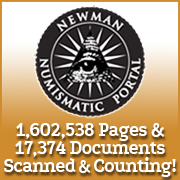
About UsThe Numismatic Bibliomania Society is a non-profit organization devoted to the study and enjoyment of numismatic literature. For more information please see our web site at coinbooks.org SubscriptionsThose wishing to become new E-Sylum subscribers (or wishing to Unsubscribe) can go to the following web page link MembershipThere is a membership application available on the web site Membership Application To join, print the application and return it with your check to the address printed on the application. Print/Digital membership is $40 to addresses in the U.S., and $60 elsewhere. A digital-only membership is available for $25. For those without web access, write to: Terry White, Treasurer AsylumFor Asylum mailing address changes and other membership questions, contact Terry at this email address: terrywhite5475@yahoo.com SubmissionsTo submit items for publication in The E-Sylum, just Reply to this message, or write to the Editor at this address: whomren@gmail.com BUY THE BOOK BEFORE THE COINSale Calendar |
- WAYNE'S WORDS: THE E-SYLUM JANUARY 10, 2018
- KOLBE & FANNING’S 2018 NEW YORK SALE APPROACHING
- NEW BOOK: IRANIAN NUMISMATIC STUDIES
- NEW BOOK: THE LAST CLOSET
- ALAN BLEVISS (1941-2017)
- NEWMAN PORTAL ADDS HOBBIES MAGAZINE
- NEWMAN PORTAL SEARCH: UNITED SOUTH TOKEN
- BUREAU OF ENGRAVING AND PRINTING IMAGE GALLERY
- ROBERT SCOT & THE DRAPED BUST DESIGN
- NOTES FROM E-SYLUM READERS: JANUARY 7, 2018
- MORE ON THE FORGERIES OF MARK HOFMANN
- QUERY: MINTMARKS ON U.S.-PRODUCED FOREIGN COINS
- DON EVERHART ON ANALOG VS. DIGITAL ENGRAVING
- VOCABULARY TERM: OBSOLETE DIE
- GEORGE WILLIAM MASSAMORE, JR. (1842-1898)
- 2017 PAN BANQUET REPORT
- 2018 NEW YORK INTERNATIONAL EVENTS
- 2018 ONTARIO NUMISMATIC ASSOCIATION CONVENTION
- 2018 BOSTON MCA CONFERENCE PLANNED
- PAPERS ACCEPTED FOR SUNDMAN LECTURE SERIES
- COIN SHOW ATTENDANCE: THE PUBLIC/DEALER RATIO
- NUMISMATIC NUGGETS: JANUARY 7, 2018
- ULBRICH COLLECTION OF SILVER INDIAN PEACE MEDALS
- ARTICLE HIGHLIGHTS MANSFIELD, OHIO PAPER MONEY
- ROMAN SILVER COINS FOUND NEAR GLOUCESTER
- MEXICAN 8 REALES BETWEEN AMERICA AND JAPAN
- HENRY MCARTHUR STRIKES FIRST COIN OF 2018
- THE 2018 ROYAL MINT FRANKENSTEIN COMMEMORATIVE
- TOKENS OF THE CHISANA GOLD RUSH
- HOW TO HANDLE SELLING TOKEN AND MEDAL DIES
- THE WWI DISTINGUISHED CONDUCT MEDAL
- QUERY: WERE THESE COINS MADE BY ISIS?
- BEP ISSUE 2018 HAPPY BIRTHDAY NOTE
- KENYAN ARTIST DESIGNS HIS OWN NEW BANKNOTES
- AUSSIE STEALS A HUNDRED TRILLION DOLLARS
- CHINA IS ALREADY LARGELY CASHLESS
- FEATURED WEB SITE: HISTORY OF PHILIPPINE COINS
Click here to access the complete archive
To comment or submit articles, reply to whomren@gmail.com
Content presented in The E-Sylum is not necessarily researched or independently fact-checked, and views expressed do not necessarily represent those of the Numismatic Bibliomania Society.
WAYNE'S WORDS: THE E-SYLUM JANUARY 10, 2018
 This week we open with a final reminder about this week's Kolbe-Fanning New York Numismatic literature sale (a blockbuster!), two new books, and the loss of a hobby leader with a
fascinating occupation.
This week we open with a final reminder about this week's Kolbe-Fanning New York Numismatic literature sale (a blockbuster!), two new books, and the loss of a hobby leader with a
fascinating occupation.
Other topics this week include Robert Scot, Mark Hofmann, Jim Charlton, George Massamore, Stephen Album, digital engraving, coin shows and conferences, Indian Peace Medals, Ohio paper money, Mexican eight reales in Japan, ISIS coins, and Kenyan banknote designs.
To learn more about Iranian copper coins, Hobbies magazine, chemical rub testing, obsolete dies, Shoo-shaan-ah gold rush tokens, Frankenstein, Mint Sports, Walter Breen's daughter Moira, Rascals and Ratbags, food poisoning, dehydration, sunburn and the first coins struck in the Philippines, read on. Have a great week, everyone!
Wayne Homren
Editor, The E-Sylum
KOLBE & FANNING’S 2018 NEW YORK SALE APPROACHING
KOLBE & FANNING NEW YORK AUCTION SATURDAY, JANUARY 13
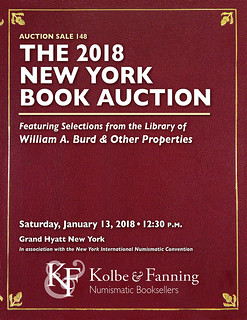 Kolbe & Fanning will be conducting our 2018 New York Book Auction this Saturday, January 13, at the Grand Hyatt hotel in New York in conjunction with the New York International Numismatic
Convention. The sale features highlights from the library of William A. Burd, as well as other properties pertaining to ancient, foreign and American numismatics. The 500-lot sale can be viewed
through our custom bidding platform at bid.numislit.com, where absentee bids can be placed in advance and where bidders can participate in the sale live. The
auction will begin at 12:30 p.m. eastern time, in Empire Ballroom I at the Grand Hyatt hotel. Lot viewing will take place in the Plymouth Room of the Grand Hyatt beginning on Thursday morning.
Bidders may participate in several different ways:
Kolbe & Fanning will be conducting our 2018 New York Book Auction this Saturday, January 13, at the Grand Hyatt hotel in New York in conjunction with the New York International Numismatic
Convention. The sale features highlights from the library of William A. Burd, as well as other properties pertaining to ancient, foreign and American numismatics. The 500-lot sale can be viewed
through our custom bidding platform at bid.numislit.com, where absentee bids can be placed in advance and where bidders can participate in the sale live. The
auction will begin at 12:30 p.m. eastern time, in Empire Ballroom I at the Grand Hyatt hotel. Lot viewing will take place in the Plymouth Room of the Grand Hyatt beginning on Thursday morning.
Bidders may participate in several different ways:
Office Phone: bids placed via our Gahanna office phone at (614) 414-0855 must be received by Monday, Jan. 8 in order to be processed.
Mobile Phone: bids placed with David Fanning via his mobile phone at (614) 256-8915 must be received by end of day Friday, Jan. 12 in order to be processed. David cannot receive calls during
the sale.
Email: bids placed with David Fanning via his email at df@numislit.com must be received by end of day Friday, Jan. 12 in order to be processed. David cannot receive emails during the
sale.
Online (Absentee): absentee bids may be placed at any time before the sale by registering at bid.numislit.com and placing bids directly online. Other bidders will not be able to see your
maximum bid, and the system will raise your bid only as needed until your maximum has been reached.
Online (Live): bids may be placed live during the sale online at bid.numislit.com (advance registration required). Live bidding can proceed quickly and
bids must be acknowledged by the auctioneer, so be alert! If possible, we will stream the auction with live audio/video.
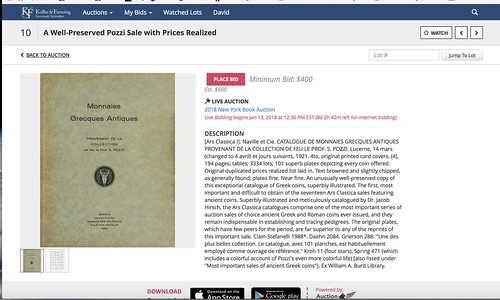
Bidders planning to participate online are strongly encouraged to register in advance to avoid any difficulties in last-minute registration (a credit card is required: it is a third-party system). Please contact David Fanning with any questions. We are looking forward to the sale and thank you in advance for your participation.
To read earlier E-Sylum articles, see:
BURD LIBRARY HIGHLIGHTS: ANCIENT NUMISMATICS (http://www.coinbooks.org/v20/esylum_v20n46a02.html)
BURD LIBRARY HIGHLIGHTS: NORTH AMERICAN NUMISMATICS (http://www.coinbooks.org/v20/esylum_v20n49a02.html)
BURD LIBRARY HIGHLIGHTS: WORLD NUMISMATICS (http://www.coinbooks.org/v20/esylum_v20n48a03.html)
NEW BOOK: IRANIAN NUMISMATIC STUDIES
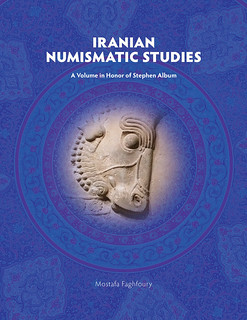 Faghfoury, Mostafa, ed. Iranian Numismatic Studies. A Volume in Honor of Stephen Album. 2017. Hardbound. Website shipping rates do not apply. (GR, OG, CA, IS, W). (X274) Faghfoury,
Mostafa, ed. Iranian Numismatic Studies. A Volume in Honor of Stephen Album. 2017. Hardbound. Approximately 275 pp. (GR, OG, CA, IS, W). (X274) $85
Faghfoury, Mostafa, ed. Iranian Numismatic Studies. A Volume in Honor of Stephen Album. 2017. Hardbound. Website shipping rates do not apply. (GR, OG, CA, IS, W). (X274) Faghfoury,
Mostafa, ed. Iranian Numismatic Studies. A Volume in Honor of Stephen Album. 2017. Hardbound. Approximately 275 pp. (GR, OG, CA, IS, W). (X274) $85
This volume is a festschrift presented in honor of the numismatist, author, and dealer, Stephen Album. The volume contains papers by important contributors on various topics on Iranian-related numismatics, both before and after the Arab invasion of Iran.
Authors (in alphabetical order) and their contributions are: Alexander V. Akopyan, Iranian Copper Coins of 16th-19th Centuries; G.R.F. Assar, An Audience with King Artabanus IV of Parthia: The Numismatic Legacy of the AD 22 Jewish Revolt; Bahram Badiyi, Two Extremely Rare AE Fractions from the Reign of Ardeshir III; Michael Bates, Who Was Named on Abbasid Coins? What Did It Mean?; William Couch, A Brief Review of Three Numismatic Sources of the Ilkhanid Coinage; Roland Dauwe, The Coinage of Simnan Province from Timur to the Qajars; Mostafa Faghfoury, Face-to-Face with Steve Album; Kiarash Gholami and Hamid R.Zohoorian, Sharik ibn al-Harith: A Governor of Istakhr; Stan Goron, The Coinage of Nadir Shah’s India campaign and its aftermath; Lutz Ilisch, The Dirham Hoard from Amul of 1973; Steve Lloyd, The Coinage and History of Ya’qub b. al-Layth; Hodge Mehdi Malek, Sistan during the Umayyad Period: Arab-Sasanian Coinage providing a chronology (AH 64 - 86) and Tabaristan during the ‘Abbasid period: The overlapping coinage of the governors and other officials (AH 144-178); Vladimir Nastich, Seven Exceptional Rarities of the Shahs of Iran; Doug Nicol, A Bibliography of Stephen Album’s Publications; Irakli Paghava, “Civic Coppers”, Profitability and Monetary Regalia: A Case Study of East Georgian Kingdom; Keith Rutter, Darics and Sigloi: Coins of the Achaemenid Kings; Susan Tyler Smith, Pseudo-Sasanian Coinage in the Name of Khusru II; and Tim Wilkes, The Coinage of the Tahirids.
A section of tributes to Steve and comments about him from Professor Jere L. Bacharach (Uuniversity of Washington), Vladimir Belyaev (the founder of www.zeno.ru), James A. Farr, Joseph Lang (CEO of Album Rare Coin), Hodge Mehdi Malek, and Wayne G. Sayles is also included.
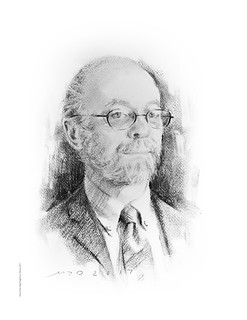 Stephen Album is the most distinguished Islamic scholar of his generation. His works are characterized by the care he takes in identifying the coins, the clarity of the pictures and the
breadth of references to literature in the field. From this carefully constructed base he offers interpretations of the data. It is both the breadth and depth of his contributions, which set him
apart from his peers in the Islamic field.
Stephen Album is the most distinguished Islamic scholar of his generation. His works are characterized by the care he takes in identifying the coins, the clarity of the pictures and the
breadth of references to literature in the field. From this carefully constructed base he offers interpretations of the data. It is both the breadth and depth of his contributions, which set him
apart from his peers in the Islamic field.
Album’s Checklist of Islamic Coins, soon out in its third edition, has become the basic guide for collectors, dealers and museums interested in Islamic coinage. His articles on issues involving the complex history of Iranian numismatics have been published in such peer reviewed journals as the British Institute’s Iran. It is however the publications of the Sylloge of Islamic Coins in the Ashmolean that have established a breadth and depth of scholarship not seen since George Miles, who received the Huntington Award in 1949.
The first volume published was on the coinage of Arabia and East Africa (1999). No previous scholarship had systematically studied the coinage of both of these areas. Album had to research an extremely wide range of sources for both areas and bring together the findings of many scholars to present a coherent picture for the separate geographic zones. The next volume dealt with the coinage of Iran after the Mongol Invasion (2001), which contains the most scholarly overview of this confusing area of numismatics, which lasts over seven centuries. With his most recent book, Pre-reform Coinage of the Early Islamic Period (2002), he has brought greater order and understanding to this complex story than any previous scholar and his work will quickly become the new base line from which other scholarly contributions grow.”
I would only add now in 2017 that Steve’s 3rd edition of his Checklist of Islamic Coins is the most important single reference for studying any period of Islamic numismatics and I anticipate that future editions will only reconfirm the fundamental importance of this work for collectors, curators, scholars and students throughout the world. Creating a digital version of his sales catalogues turned an important reference into an essential one as the inclusion of images allows a worldwide audience to draw upon this reference as a source for scholarship as well as collecting. In addition, Steve has always been generous in answering my numerous questions over the decades as we have known one another since the 1970s.
For more information, or to order, see:
Iranian Numismatic Studies. A Volume in Honor of Stephen Album. 2017 (https://www.cngcoins.com/Shop_cart.aspx?ITEM_ID=341719)
NEW BOOK: THE LAST CLOSET
 Marion Zimmer Bradley was a bestselling science fiction author, a feminist icon, and was awarded the World Fantasy Award for lifetime achievement. She was best known for the Arthurian
fiction novel THE MISTS OF AVALON and for her very popular Darkover series.
Marion Zimmer Bradley was a bestselling science fiction author, a feminist icon, and was awarded the World Fantasy Award for lifetime achievement. She was best known for the Arthurian
fiction novel THE MISTS OF AVALON and for her very popular Darkover series.
She was also a monster.
THE LAST CLOSET: The Dark Side of Avalon is a brutal tale of a harrowing childhood. It is the true story of predatory adults preying on the innocence of children without shame, guilt, or remorse. It is an eyewitness account of how high-minded utopian intellectuals, unchecked by law, tradition, religion, or morality, can create a literal Hell on Earth.
THE LAST CLOSET is also an inspiring story of survival. It is a powerful testimony to courage, to hope, and to faith. It is the story of Moira Greyland, the only daughter of Marion Zimmer Bradley and convicted child molester Walter Breen, told in her own words.
To read the complete article, see:
The Last Closet: The Dark Side of Avalon (https://www.goodreads.com/book/show/37494480-the-last-closet)

ALAN BLEVISS (1941-2017)
On December 30, 2017 Civil War Token Society President Susan Trask wrote:
It is with much sadness I report on the passing of our fellow CWTS member, Alan Bleviss. I have spoken with his daughter Sarah.
Alan was a larger than life presence in the CWTS, a past president of the society and will missed as a member on our Board of Governors.
CWTS Past President Scott A. Blickensderfer wrote:
Alan was honestly the first CWTS member whose hand I shook upon joining the organization. He was idealistic, enthusiastic, and a genuinely good man. He embodied the Society for its roots as a collector organization. We are richer for knowing him, and poorer for losing him.
From Wikipedia:
Bleviss was born and raised in Edmonton, where his father owned several theaters and a cigar store. He was educated at the University of Alberta and the National Theatre School of Canada. He lived in the New York City area at the height of his career from the late 1970s to the early 1990s, and passed away at his home in New York City on December 30, 2017.
He did political work for the National Abortion Rights Action League and many Democratic Party campaigns, including the 1988 campaign of Michael Dukakis for President.
Bleviss served on the Board of Directors of the National Theatre School of Canada, and funded scholarships and a student theatre facility at the University of Alberta.
Bleviss is the inspiration for a sandwich called "The Edmonton" at Shopsins, a diner in Manhattan. He is a well-known collector of Civil War tokens, unofficial currency of the early 1860s. In 2009, he auctioned off 500 items from his collection, described by the auctioneer as "one of the most extensive holdings ever assembled".
To read the complete article, see:
Alan Bleviss (https://en.wikipedia.org/wiki/Alan_Bleviss)
From a University of Alberta profile:
Bleviss wears his sense of humour prominently, and will happily tell you about some of the pranks he pulled while at the University of Alberta. His puckish nature even stretches into his philanthropy — including naming a theatre scholarship and two facilities in the surname of his deceased father, Joe Bleviss, who disdained plays and refused to fund Alan’s education. (Motkovich is his mother’s maiden name.)
Though the elder Bleviss once owned two performance venues in Edmonton, the Varscona and the Roxy — plus the former Garneau movie theatre — he saw them strictly as business ventures. As was Hub Cigar Store, which he tried to give his eldest son in order to dissuade him from pursuing schooling in the arts.
Bleviss was unfazed by his father’s objections; he followed his love and became a gifted stage actor. But it was a Canada Dry voice audition that earned him his prestige. “It was something like, ‘From the salt spray of the Pacific Ocean to the wheat fields of Alberta … the champagne of ginger ales.’ And then I got my first paycheque. It would have taken me months to earn what I earned in an hour. I continued theatre, but in my lunch hours I would grab a bag of chips and then go do commercials.”
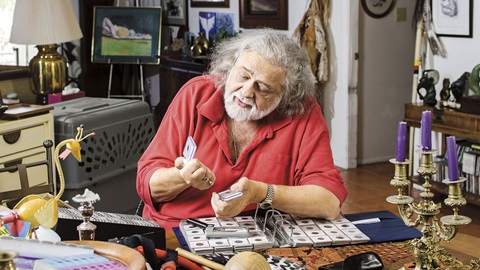
To read the complete article, see:
The Voice (https://www.ualberta.ca/giving/giving-news/2015/january/the-voice)
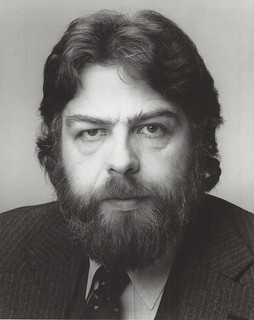 How do you capture the essence of a man of seventy-six in just a few moments? Especially when that man is your father?
How do you capture the essence of a man of seventy-six in just a few moments? Especially when that man is your father?
My father lived a full and remarkable life, overcoming tremendous adversity time and time again. Many of you know my father as the voice of a generation, a mentor to young artists, a generous philanthropist, phenomenal bridge player, Joan Jett fan and a lover of jokes. I know my father as the son of Joe Bleviss, a cigar-shop owner and entrepreneur and Lee Bleviss, a doting and supportive mother. I also know him as a fellow leo: strong, passionate, loyal and wildly determined.
He taught me to have a strong sense of self and an even stronger moral compass. A proud union man, he put me on the picket lines with him as a kid and encouraged me to pursue my passions fully, no matter what they were. He told me to figure out what I love doing and make a living doing it. I am proud to say I have achieved that goal with his blessing.
Above all else, my father was a fighter. He didn’t let his physical impairments hold him back, fought not once but twice to regain his paralyzed vocal chords, achieved his dreams as a stage actor and voice over and traveled the world with his children.
Without my brother’s devotion and courageous care for our father in the year before he moved to New York, and without the tremendous research skills of his partner Tessa and my sister Lisa, I could not have been prepared to provide the care for my father over last sixteen months of his life. We spent long evenings together eating takeout and talking about his childhood and my own. We talked about his adventures in theatre school, his connection to Judaism and his lifelong friendships with people like my Uncle Augie. We went to see jazz, to a Chapel Hill game and spent hours in Washington Square Park people watching.
The last sixteen months has been the most humbling and also the most profound gift of my life. It has been nothing short of an honor to support my father, to be his witness, his confidant and to shower him with the love and care he deserved.
The night before my father died, he said:
”Tomorrow I will go. I’m going to go for a short trip. We’ll go on a star.”
I responded, “When you see the stars at night will you think of me Dad? I will think of you.”
To which he replied: “When it gets dark then I will think of you. Of all of you.”
My father passed on December 30th, the sabbath. It is said that only tzadikkim, the righteous holy people, leave their bodies on Shabes. He was able to say goodbye to his partner, Tessa, his beloved children Joshua and Lisa and I held his hand and told him we would be okay and love him always. He told me he would love us always, too.
His last wishes were that his children get along, take care of one another and live their lives as authentically as possible. I ask that we all leave today working towards tikkun olam, repairing the world, by caring for one another and living as authentically as possible. Dad, your memory will forever be a blessing.


Call it MSI - Mass Subliminal Infiltration. It booms from speaker banks at movie theaters, from TVs and Walkmans, from cars and kitchen radios across the land - everywhere there is That Voice.
Sonorous and sincere, it can be heard hawking everything from abortion rights to disposable diapers, from presidential candidates to the American Express Gold Card, from Truth or Dare to sex, lies, and videotape.
The assured, honeyed vocal cords belong to one Alan Bleviss, a lapsed Canadian who makes his home in North Jersey and his living in New York. Bleviss, whose voice radiates conviction, confidence and confection in equal amounts, narrates movie trailers and commercials.
Chances are you've heard him: "From the director of last year's most beloved movie . . . comes a magical new tale," he oozed of Everybody's Fine, the art-house followup to Academy Award-winner Cinema Paradiso.
Bleviss first deployed his sexiness, authority, warmth and confidence-that- you-can-trust as an actor north of the border. But the '60s graduate of the National Theater School of Canada found it hard to make ends meet. "I found it very difficult to live on $75 a week, maintaining two apartments - one where I lived and one that I had to rent on the road."
One day, his agent suggested an audition for a voice-over job.
"My first audition was for McDonald's," Bleviss recalls. "I looked at the script and thought, 'What a piece of junk,' and I walked out. I was a proud actor.
"And there are still actors who feel that commercials are beneath them. But I treat each commercial as an acting job."
Bleviss never did do anything for McDonald's. But his next audition was for Canada Dry ginger ale, and he landed the job. The soda spot turned into a series of commercials ("They wanted a great big bold sound, almost like you were the entire country"), and soon Bleviss was working his way through recording studios and sound labs, script in hand and mouth at the ready.
Through the mid-'70s, Bleviss mixed his voice work with an acting career, but before long the former took precedent. And then came the movie trailers.
"The first one I ever did was for Emerson, Lake and Palmer's concert film Pictures at an Exhibition . . . And the next trailer I did was for Richard Gere's movie, Days of Heaven - the most beautiful thing I've ever seen in my life. Then Ragtime, and then I can't even tell you because they just sort of flew."
In 1976, the Big Apple beckoned. While most of his narrating colleagues - Don LaFontaine, Brian Cummin, Chuck Riley and Gene McGarr are some of the biz's top names - are based in Los Angeles, Bleviss opted to remain in New York, which is another reason he's found himself so busy with Miramax, a Manhattan-based independent.
Bleviss sees his work as an extension of his acting career. And sometimes he's so convincing in his two-minute spiels that he'll go see the film he's just talked up. "Sometimes I sell myself," he admits, "though really the writer has sold me."
Doing trailers, he explains, "is really a team effort, because someone has to write the script, someone has to edit the film, they have to pick the shots - and I don't think that's so easy."
"I could never edit, and I could never write the words, but once they give me the words, I love to create with them. I like doing trailers best - even though I do more commercials - because they give me a great deal of freedom to create. . . .
"A lot of people think that anybody can do it, but really you have to have a concept of English, and you have to be able to communicate. You have to understand what the words mean. What the ideas are. And then you have to communicate it to millions of people, but on a one-to-one basis.
NEWMAN PORTAL ADDS HOBBIES MAGAZINE
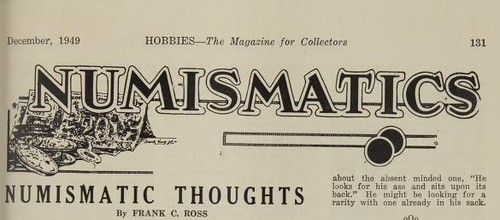
Hobbies Magazine, launched in 1931, for many years carried a numismatic section. Typically six or eight pages, columnists included Frank C. Ross, Thomas Elder, Charles French, and others. The Elder columns are particularly rich, with reminiscences of Elder’s early days found nowhere else. The Newman Portal has scanned the numismatic sections of Hobbies for the period 1949 to 1977.
We have access to a run from 1931 to 1941 and are searching for the remainder. Readers who might wish to loan copies may contact Newman Portal Project Coordinator Len Augsburger at leonard.augsburger@wustl.edu. Many thanks to Pioneer Communications, publisher of Treasures (the successor to Hobbies) who kindly granted permission to present this material on Newman Portal.
Link to Hobbies Magazine on Newman Portal:
https://nnp.wustl.edu/library/publisherdetail/523056
NEWMAN PORTAL SEARCH: UNITED SOUTH TOKEN

This week a Newman Portal user searched for “United South Token.” By coincidence, I had seen such a token on the bourse of the FUN show in Tampa the same day. This is a contemporary Confederate silver token, sometimes referred to as a Confederate half dime. The piece depicts a Confederate flag on the obverse, and southern agricultural products on the reverse. The token is mentioned in the New York Times in 1878, which in turn reported a discovery date of 1862. Only about a dozen are known, with one dug from a Tennessee battlefield.
Image: A UNITED SOUTH token, from Stack’s Americana sale, January 2008, lot 7233 (realized $6,325).
Link to Stack’s Americana sale, January 2008, on Newman Portal:
https://nnp.wustl.edu/library/auctionlots?AucCoId=3&AuctionId=516991&page=293
Link to earlier discussion in The E-Sylum:
https://nnp.wustl.edu/library/periodical/514361

BUREAU OF ENGRAVING AND PRINTING IMAGE GALLERY
Since its establishment in 1862, the Bureau of Engraving and Printing has accumulated around two million objects that touch upon its history as the security printer of the United States. These artifacts are often derived from the process of producing currency, stamps, and other miscellaneous products and include art work, printed proofs of engravings, and final products. There are also numerous photographs depicting the people, places, and processes of the BEP.
While BEP products such as currency and stamps can be easily viewed across the Internet, this Image Gallery presents those items that are not so readily available.
The objects presented here have been selected for their fine artistic merit as well as their uniqueness in illustrating various facets of BEP’s and America’s past.
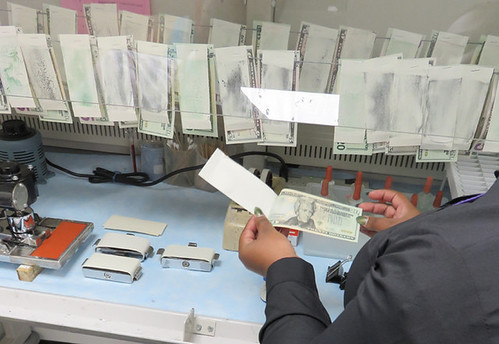
Notes undergoing chemical rub testing in the Quality Assurance Division laboratory
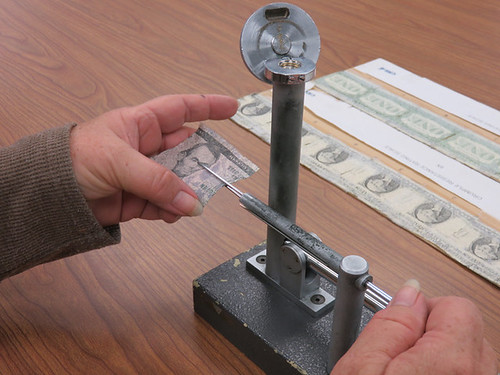
The Durability Laboratory performs a crumple test on a $5 note to assess ink flaking
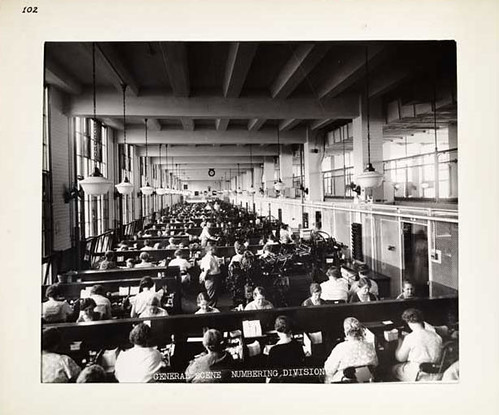
Photographic Print, Numbering Division, c.1930s
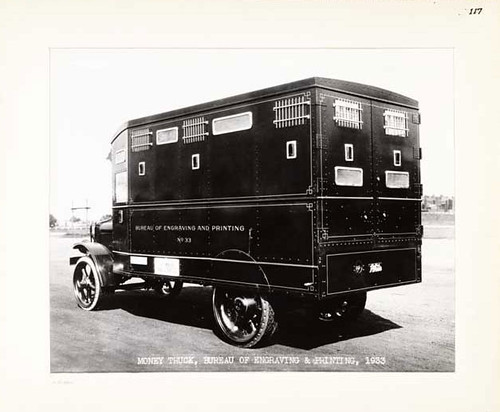
Photographic Print, Bureau of Engraving and Printing Armored Truck, c.1933
To view more images, see:
Resources : Image Gallery (http://www.bep.gov/resources/imagegallery.html)
ROBERT SCOT & THE DRAPED BUST DESIGN
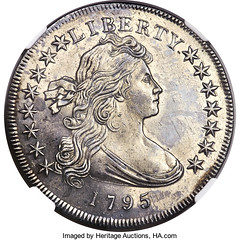 This response is regarding the 12-24-17 E-Sylum that requested comments from readers for coins including a very impressive 1795 Off-Center Draped Bust dollar, graded NGC SP62, from
the Heritage FUN auction.
This response is regarding the 12-24-17 E-Sylum that requested comments from readers for coins including a very impressive 1795 Off-Center Draped Bust dollar, graded NGC SP62, from
the Heritage FUN auction.
The lot #1271 auction description for the 1795 Off-Center Draped Bust dollar stated “The designer and engraver remain unidentified”.
The subject of the Draped Bust designer and engraver was previously debated on the E-Sylum from 3-28-2010 to 4-25-2010. Additional contemporary evidence has been published since that time. Chief Engraver Robert Scot’s engraving report to the Congressional “Committee on the Mint” was first published in full within my August, 2012 John Reich Journal article, and also in my book Robert Scot: Engraving Liberty. The key paragraph from Scot’s December, 1794 report reads:
“It may be necessary in this remark to enumerate (to the Committee on the Mint) what I think the actual duties of my office are. Viz. Engraving and sinking all Original Dies, raising and finishing all Hubbs that are struck out of them, and raising and finishing all punches that may be requisite to the completion of Dies or Hubbs; letter punches excepted. These may be imported or procured from those of that profession.”
Elias Boudinot, Congressman from New Jersey and head of the Committee on the Mint, condensed Scot’s report and communicated to the House of Representatives on February 9, 1795:
“The Engraver, whose actual duties are the raising and furnishing all punches that are requisite for the completion of the dies, the engraving and sinking of all Original Dies, and raising all Hubbs that are struck out of them. He has an assistant, occasionally, as the business is urgent.”
Elias Boudinot became Director of the Mint in October of 1795. Boudinot published “Orders and Directions for Conducting the Mint of the United States” dated November 2, 1795 to set rules, policies, and procedures for the Mint, including the Engraver. Boudinot’s work was printed by John Fenno in 1796. From page 29:
“The Engraver. It is his duty to have prepared and to engrave all the dies necessary for the Mint, as ordered from time to time by the Director, and to provide such a number of each denomination on hand, as to prevent unnecessary delays that may be occasioned by breaking &c. He will be allowed a forger and hardener of dies to prepare and temper the same.”
The “Original Dies” are the device designs for Liberty and the Eagle. These important events established engraving policy for the Mint in 1795, and represent conclusive evidence that Robert Scot, appointed Engraver of the Mint by President George Washington, was the engraver of the Draped Bust designs.
To read earlier E-Sylum articles, see:
ROBERT SCOT & THE DRAPED BUST DESIGN (http://www.coinbooks.org/esylum_v13n17a13.html)
NUMISMATIC NUGGETS: DECEMBER 24, 2017 : 1795 Draped Bust Dollar (http://www.coinbooks.org/v20/esylum_v20n53a14.html)
NOTES FROM E-SYLUM READERS: JANUARY 7, 2018
Query: 1893 Columbian Exhibition Medal Winners Sought
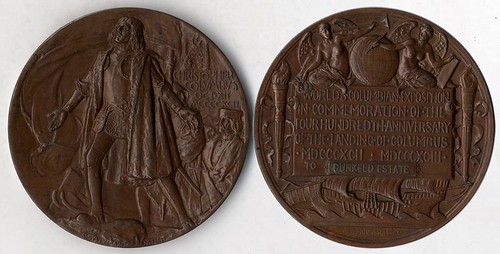
Geoff Bell writes:
Could any of our readers tell me where I can locate a list of people/businesses/others who were awarded medals at the 1893 Columbian exhibition? Thank you.
Can anyone suggest a particular title or report that might include this information? Another source would be contemporary newspapers - no doubt there were daily accounts of the announced winners, but of course it would be easier if there were a post-event report listing them all together.
Above is an image of a large bronze Columbian Exposition medal by Augustus Saint Gaudens (obverse) and Charles Barber (reverse). -Editor
To read the earlier E-Sylum article, see:
COINS, MEDALS AND TOKENS: JANUARY 8, 2017 : 1893 World's Columbian Exposition Medal: DUNKELD ESTATE
(http://www.coinbooks.org/v20/esylum_v20n02a27.html)
On Naming Pattern Coin Designs
 With regard to the Schoolgirl dollar, the following is what I placed years ago on the uspatterns.com website.
With regard to the Schoolgirl dollar, the following is what I placed years ago on the uspatterns.com website.
The "Schoolgirl" dollar considered to be one of the most beautiful designs ever. The schoolgirl name dates back to the April 1891 New York Coin and Stamp sale auction of the F.W. Doughty collection and was apparently given by David Proskey. This is noted by Edgar Adams on page 367 of the October 1911 edition of The Numismatist.
Regarding the Doughty coin, it was purchased by Clay (H.P. Smith) and is apparently the piece sold in the 1906 Chapman brothers sale of his collection and was purchased there by John Story Jenks. From there it was purchased by J. H. Clapp according to a named copy of the Jenks sale which was offered in a Kolbe book auction over a decade ago. From there it went to Eliasberg and was sold in the Bowers & Merena sale.
As for the other “named” patterns, the Doughty sale was the first to use the term Amazonian for the 1872 silver patterns and Wash-lady for the 1879 silver patterns.
It is believed that Proskey is the source for all of these “names”.
To visit the uspatterns site, see:
http://uspatterns.com/
To read the earlier E-Sylum article, see:
NEWMAN PORTAL SEARCH: “SCHOOL GIRL” (http://www.coinbooks.org/v20/esylum_v20n54a08.html)
Model Crowns and Model Coinage
David Powell writes:
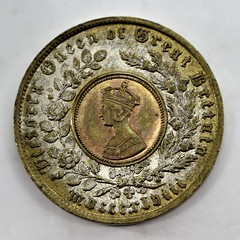 I believe that "Model Crowns", and other designated "Model Coinage", are essentially toy money, typically British and from the mid-late 19th century, sometimes combined
with a hint of what a revised coinage might look like. From the late 1840s onwards Britain was contemplating both (i) revising the format of its low-value coinage and (ii) going decimal.
I believe that "Model Crowns", and other designated "Model Coinage", are essentially toy money, typically British and from the mid-late 19th century, sometimes combined
with a hint of what a revised coinage might look like. From the late 1840s onwards Britain was contemplating both (i) revising the format of its low-value coinage and (ii) going decimal.
The replacement of the British copper coinage by bronze in 1860 is well known, but for 15 years before various people, some of them interested in going decimal at the same time, were pumping their ideas out. Model coins, doubling up as children's toy money, were part of the publicity for this and, the idea of toy money as a children's plaything having been established, continued with various imaginative designs long after the original decisions regarding the main issues had been made.
Pieces of this type, not all of which incorporate the word "Model", are mostly quite common and appear fairly regularly on eBay. They are mostly small or very small, a few of them down to about 7mm diameter, which explains why the word is often omitted, except on the larger values. The reputed denominations cover the whole normal range and beyond, descending as far as a sixteenth of a farthing.
To read the earlier E-Sylum article, see:
NUMISMATIC NUGGETS: DECEMBER 31, 2017 : Victoria Model Crown (http://www.coinbooks.org/v20/esylum_v20n54a23.html)
More on Dealer Ken Nichols
Regarding coin dealer Ken Nichols, an E-Sylum reader writes:
I’ve always wondered who Ken Nichols was, and now I know the rest of the story. I attended college in Southern California, 1963-1967. I can’t remember how I was aware of Ken Nichols - perhaps an ad. I bought from him an 1875-S trade dollar for $65.00. That was a lot of money for a college student! He described it along the lines “as nice as I have seen” or something like that. It was later slabbed...MS65. Along came the boom in silver prices and boom in coin prices...around 1980 I sold the coin for $16,000.00!!!!
I also went to Abner Kreisberg’s store in L.A. He was always in the back. I’d buy coins from Jerry Cohen. I remember buying an Indian $10 from Jerry.
To read the earlier E-Sylum article, see:
STUNT PILOT COIN DEALER: KEN NICHOLS (http://www.coinbooks.org/v20/esylum_v20n54a10.html)

MORE ON THE FORGERIES OF MARK HOFMANN
Douglas Adams writes:
I read the book review in the last issue by Emily Isakson on The Judgment of Experts - it's a fascinating read. It just so happened I had been contemplating a short post over on the Coin Talk forums that I finally finished and thought your readers might find it interesting.
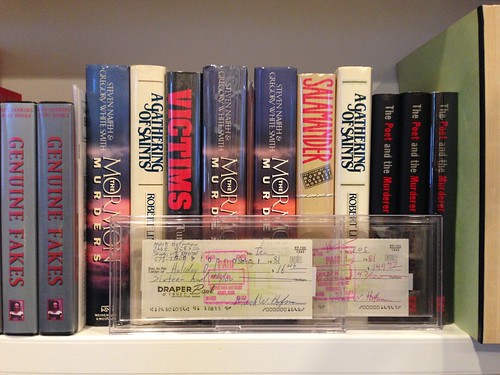
To the consternation of many of my biblio-friends I took up coin collecting about 5 years ago after the rediscovery of my childhood collections that had survived intact in my mother’s attic. The thought that two collections, two intense interests, could coexist seemed unfathomable to them.
Coin collectors, however, have no doubt of the importance of books in their endeavors as the tutelage given all budding numismatists is “buy the book before the coin.” I myself have, and continue to follow this sound advice and have begun to build a small numismatic library, but this seems not to count among my more literary minded friends. I must continually stress to my biblio-friends that a book is a book and that my love for books has not diminished in the least, even though I may divert some of my resources to the numismatic collections that would have in the past been directed into the literary collections I still find I’m able to enjoy my paper collections and metal collections equally.
I had not thought it possible to merge my two interests – coins and books – seamlessly into each other but I’ve discovered a few instances where my two hobbies joyously collide:
The Mormon Bomber?
Mark Hofmann, a book and antiquities dealer operating in Salt Lake City, began his illicit career in his young teenage years by “improving” coins, whereby he would add mintmarks making a common coin rare. Later, he progressed to forging Mormon scrip money and then documents and manuscripts relating to The Church of Jesus Christ of Latter-day Saints.
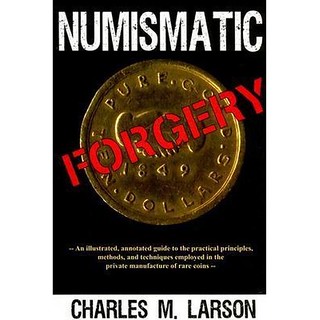 Hofmann evidently became quite proficient in creating numismatic rarities and in fact operated as a teenage dealer under the business name of "Mark's Mint Mistakes". In 2002,
Hofmann made claim to creating the controversial 1959-D Lincoln Cent Mule, which notably passed Treasury Department inspection but remains an anomaly.
Hofmann evidently became quite proficient in creating numismatic rarities and in fact operated as a teenage dealer under the business name of "Mark's Mint Mistakes". In 2002,
Hofmann made claim to creating the controversial 1959-D Lincoln Cent Mule, which notably passed Treasury Department inspection but remains an anomaly.
According to a New York Times article, Hoffman’s forgeries were the most sophisticated ever seen, fooling nearly all the top forgery experts in the country. Charles Hamilton, the preeminent document dealer and expert in forged manuscripts, wrote that “Mark Hofmann was unquestionably the most skilled forger this country has ever seen”:
He fooled me — he fooled everybody.… Investigators have said that Mr. Hofmann was as successful in selling forged documents in New York as he was in Utah. They say he may have collected more than $2 million selling rare documents purportedly written or signed by such literary and historical figures as Charles Dickens, Mark Twain, Jack London and Jim Bridger.… The Federal Bureau of Investigation said they could find no evidence that [his documents were] forged.
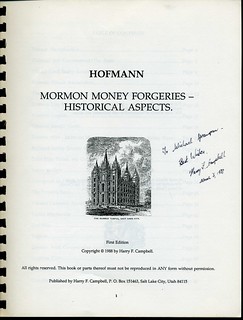

To read the complete article, see:
Collections in Collision - Coins & Books / Books & Coins
(https://www.cointalk.com/threads/collections-in-collision-coins-books-books-coins.308602/)
To read about the 1959-D Mule Lincoln Cent, see:
The Mystery of the 1959-D Mule Lincoln Cent
(https://www.pcgs.com/news/the-mystery-of-the-1959-d-mule-lincoln-cent)
To read the earlier E-Sylum article, see:
BOOK REVIEW: THE JUDGMENT OF EXPERTS (http://www.coinbooks.org/v20/esylum_v20n54a06.html)
QUERY: MINTMARKS ON U.S.-PRODUCED FOREIGN COINS
I'm trying to ascertain why some foreign coins stuck at United States Mints during WWII bear a U.S. Mint mark. Published statements are consistently vague. Examples:
Charles G. Altz & E.H. Barton (Foreign Coins Stuck At United States Mints, Whitman Publishing, 1965, one of the “Black Books") wrote:
“Some coins bear United States mint marks; this seems to depend upon the contract.” (not numbered, p.7).
Tim Ziebarth (pdxcoinclub.org), Foreign Coins Manufactured at US Mints, March 2006, wrote:
“Each coin made by the U.S. Mint for another country was minted to the specifications dictated by the client country.” (pg.2).
Any insights or references would be appreciated.
The production of foreign coins by US Mints began in 1833 with the striking of a Liberia (LR) one cent coin. The Liberia one cent, in essence a token dated 1833, was struck by the Mint for the American Colonization Society, founded in 1817 for the sole purpose of transporting “freeborn blacks” and “emancipated slaves” back to Africa.
The U.S. Mint had long been in the business of striking medals for various groups and artists. In fact, the U.S. Mint was the only place to go in North America if you wanted a large sized medal struck, since no other equipment was available that could handle the immense pressures required to strike such pieces. The prospect of the mint manufacturing tokens, as in the case of the Liberian cents, was not a far offshoot from the medal making business. It is believed that the medal manufacturing activities of the mint led to some of the very first foreign coinage struck by the U.S. Mint.
The one-cent token featured “Freed Negro” standing next to a palm tree, with a ship in the distance. Though many regard the one-cent piece a “hard times” token, and thus not acknowledged by the US mint as foreign coinage in its annual reports, it did function as coinage in the Liberian colony
Official and wide-scale minting of Foreign coins began in the US with the passage of the Act of January 29, 1874 which read:
“Be it enacted by the Senate and House of Representatives of the United States of America in Congress assembled, That it shall be lawful for coinage to be executed at the mints of the United States, for any foreign countries applying for the same, according to the legally prescribed standards and devices of such country, under such regulations as the Secretary of the Treasury may prescribe; and the charge for the same shall be equal to the expense thereof, including labor, materials, and use of machinery, to be fixed by the Director of the Mint, with the approval of the Secretary of the Treasury: Provided, That the manufacture of such coin shall not interfere with the required coinage of the United States.”
The first coins struck under this new authorization were 1 and 2 ½ centavo issues in 1875-76 for Venezuela in a Copper-Nickel-Zinc (mintage of 10 and 2 million respectively) at the Philadelphia Mint, and were dated 1876 and 1877.
To read the complete article, see:
Foreign Coins Struck at U.S. Mints
(http://pdxcoinclub.org/articles/Foreign%20Coins
%20Struck%20at%20US%20Mints%20CWNA%20article%20with%20table.pdf)
A check of the Newman Portal came up empty, but that's a very hard query to frame. While I'm sure there've been some great articles over the years in publications like Coin World and COINage, these are not in the portal. Can anyone point us to an answer to the mint mark question?
Meanwhile, I'd also be curious to learn the documentation behind the claim the the 1833 token was mint-struck. Where did this assertion first appear in the literature? What evidence was cited? In 2012 Eric von Klinger disputed this in a 2012 E-Sylum article. -Editor
Eric von Klinger wrote:
The claim is sometimes made that the U.S. Mint struck the 1833 American Colonization Society coppers for Liberia, but this claim is probably in error. Congress first authorized the Mint to accept foreign coinage contracts in an act of 1874.
To read the complete article, see: A VERY AMERICAN CENT! THE ACS LIBERIA CENT TOKENS OF 1833 (https://www.archive.org/stream/PennyWiseVol40No5#page/n3/mode/2up)
To read the complete article, see:
Freed slaves in Sierra Leone order coins struck in Britain
(https://www.coinworld.com/news/world-coins/2018/01/freed-slaves-in-sierra-leone-order-british-struck-coins.html)
To read the earlier E-Sylum articles, see:
DOMESTIC AND FOREIGN COINS MANUFACTURED BY MINTS OF THE U.S (http://www.coinbooks.org/esylum_v15n41a16.html)
MORE ON DOMESTIC AND FOREIGN COINS FROM U.S. MINTS (http://www.coinbooks.org/esylum_v15n42a08.html)
DON EVERHART ON ANALOG VS. DIGITAL ENGRAVING
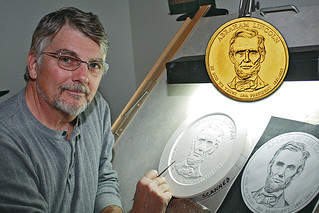 In regards to the article on the quality of the Janvier vs. the digital process, I have a few comments. I do agree that the Janvier made very nice reductions. I also think the digital
process makes beautiful reductions.
In regards to the article on the quality of the Janvier vs. the digital process, I have a few comments. I do agree that the Janvier made very nice reductions. I also think the digital
process makes beautiful reductions.
The distinction, however lies with the ability of the artist making the initial model. In my time at the United States Mint I utilized both processes. We started using the digital process around 2009 I sculpted exclusively in clay and plaster. When I was finished with the model it went to a scan, and ultimately, the CNC process of reduction.
The Janvier reduction pattern is circular, like the grooves on a vinyl record. The digital reductions were accomplished with a back and forth method, similar to how a TV reproduces images. The die cleaners at the Mint felt the digital reductions were easier to clean. Removing the reduction lines must be done in both processes.
The biggest distinction, in my mind, however, was the ability of the artist in the initial sculpting process. I felt that the images that were sculpted digitally, on a computer did not have the same emotive power of the hand sculpted designs. They appeared to me to not have as much spontaneity. Of course, the responsibility is on the artist to make a convincing and competent sculpt from an existing design.
That is not to say that in the hands of a master sculptor a level of beauty and perfection cannot be obtained using Freeform or Z Brush, or some other digital sculpting program. I have seen work from digital sculptors that is truly exceptional. And I have seen traditionally sculpted medals that were incompetent.
I resisted the digital movement when it first came the the Mint, but after a while, I saw the benefits of it. For one thing, changes and edits to the final model are much quicker and more detailed than can be obtained using plaster models. One does not have to go through the whole process of casting and re-casting to fix a small imperfection. So it was a major time-saver when faced with the tight deadlines of a commercial mint. It also freed the sculptor from having to go through the process of creating lettering on the plaster model.
I learned how to do lettering in plaster from my days at the Franklin Mint and my 24 year freelance career. Not having to go through the time consuming task of creating letterting in plaster gave me more time to work on and perfect my portrait, or whatever subject matter I was tasked to create.
So, in conclusion, although I felt the Janvier reductions were fine, I also saw the advantages of sculpting the model in plaster, then finishing or editing the final digital model.
To read the earlier E-Sylum article, see:
WHY JANVIERS SHOULD NOT BE SCRAPPED (http://www.coinbooks.org/v20/esylum_v20n54a15.html)
VOCABULARY TERM: OBSOLETE DIE
In our study of dies the term “obsolete die” comes up often. This is understandable because there are a great quantity of such dies in existence. Mints are hesitant to dispose of special dies which are no longer in production but may have use again. This does not apply to current coin dies where hundreds are necessary for large quantity production. These are destroyed, defaced and sold for scrap metal.
Obsolete Die. A die no longer useable for striking; one incapable of producing perfect strikes, or whose use has been revoked. Obsolete dies are usually the ones used
to create RESTRIKES. Some obsolete dies are CANCELLED, by obliterating a portion of the striking surface (so perfect specimens cannot be struck). Other obsolete dies are placed in archives, most are
scrapped, but some dies end up in collectors’ hands. Some mints retain obsolete dies. The Paris Mint, for example, has thousands of such dies. These are stored in DIE VALUTS that control the humidity
to prevent rusting. Despite this, most obsolete dies exhibit evidence of use, often extensive wear, rust, corrosion, or even sinking. Also old dies do become somewhat brittle in time.
CLASS 04.4
Looking for the meaning of a numismatic word, or the description of a term? Try the Newman Numismatic Portal's Numismatic Dictionary at: https://nnp.wustl.edu/library/dictionary

GEORGE WILLIAM MASSAMORE, JR. (1842-1898)
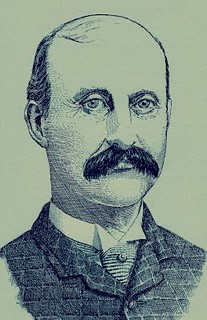 Dr. George W. Massamore, Jr., is a fascinating personality : Confederate soldier, politician, musician, dentist, optician, fish and game warden, dog breeder, baseball team owner,
philatelist, numismatist, coin and stamp auction cataloger, coin and stamp dealer, autograph, and Indian relic collector, and author. In his fifty-six years he accomplished much as an active citizen
and hobbyist.
Dr. George W. Massamore, Jr., is a fascinating personality : Confederate soldier, politician, musician, dentist, optician, fish and game warden, dog breeder, baseball team owner,
philatelist, numismatist, coin and stamp auction cataloger, coin and stamp dealer, autograph, and Indian relic collector, and author. In his fifty-six years he accomplished much as an active citizen
and hobbyist.
George William Massamore, Jr. (1842-1898), was born on March 5, 1842, at Manchester, Carroll County, Maryland, son of George Massamore, Sr. (1802-1877), a shoe maker, and Elizabeth Massamore (1814-1877).
In 1861, at age nineteen he enlisted in the Army of the Confederate States of America fighting under the command of General Elwell. In 1868 he graduated from the Baltimore College of Dental Surgery.
In October 1880, he was a founding member and secretary of the Numismatic and Archaeological Society of Baltimore.
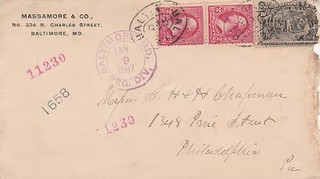
From December 1880 to June 1897 he held 46 predominantly stamp & coin auction sales, mainly but not exclusively conducted by William Seemuller.
In 1881, he married Susan R. House Harding (1838-1918), widow of William Henry Harding. They had four children.
In 1881, he was elected a corresponding member of the ANS.
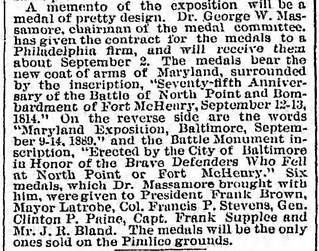 From 1883 to 1884, he was a baseball manager/owner at Baltimore for a baseball team in the Union League, the Monumentals. In November 1883, he was chairman of the committee of the Union
League to meet with the National League at Washington, D. C. in order to seek recognition.
From 1883 to 1884, he was a baseball manager/owner at Baltimore for a baseball team in the Union League, the Monumentals. In November 1883, he was chairman of the committee of the Union
League to meet with the National League at Washington, D. C. in order to seek recognition.
In 1889, he published Descriptive and Chronological Catalog of Confederate Currency.
Augustus G. Heaton's classic article, "A Tour Among the Coin Dealers" The Numismatist, January (1895) :
"Baltimore comes next in our tour. Dr. George Massamore is there to be sought in two or three places. As a coin dealer, he has a counter, showcase, and fireproof and show window in one side of the store on North Charles Street, the other side being given up to an optician's business. As a dentist he is found at times at his residence, and as a politician he has long held some office at this City Hall. There he is perhaps now less occupied, as the Republicans have been drawing so many teeth of late that his party has very little of even a jaw left. Dr. Massamore is of middle age, of mild pleasant manner, somewhat bald, and has been known many years as a coin dealer of experience and a cataloguer of many collections."
He died on April 7, 1898, and is buried in Loudon Park Cemetery, Baltimore, Maryland.
To read the complete article, see:
MASSAMORE, Dr. GEORGE WILLIAM
(https://sites.google.com/a/numismaticmall.com/www/numismaticmall-com/massamore-george-william)
The entire inventory of the Lupia Numismatic Library is for sale. Individual items will be available before the remaining archives are broken up into parcels sold at philatelic auctions in the U. S. and Hong Kong. Check NumismaticMall.com frequently as dozens of new items with estimates will be posted daily until everything is sold.
All inquiries will be given prompt and courteous attention. Write to: john@numismaticmall.com .
2017 PAN BANQUET REPORT
The PAN Banquet held on Thursday evening October 26th was a stellar evening at the beautiful five-star LeMont Restaurant overlooking the stunning view of the city of Pittsburgh. Mr. Donald Scarinci presented a talk, “A Brief History of the J. Sanford Saltus Award.” The award was initiated in 1913 by J. Sanford Saltus to reward sculptors "for distinguished achievement in the field of the art of the medal." A. A. Weinman, one of the finest American sculptors of the Beaux-Arts tradition and the second winner of the award, designed the silver medal presented by the American Numismatic Society.
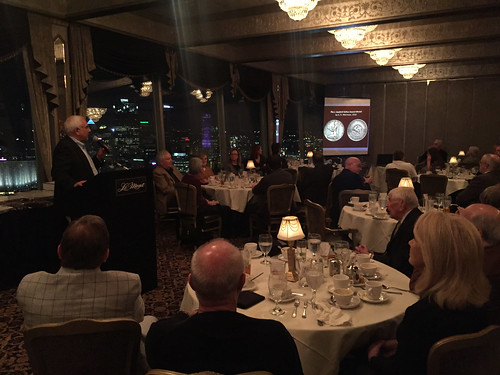
Don Scarinci at podium

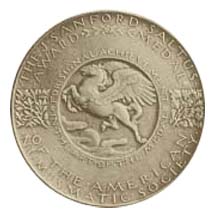
J. Sanford Saltus Award Medal
Don Scarinci is an attorney and founding partner of Scarinci and Hollenbeck, LLC located in Lyndhurst, NY. He also serves as a member of the Citizens Coinage Advisory Committee, which is required by law to review and recommend designs for all coins and medals issued by the United States Mint. Don is a member of the ANS panel of experts to award the J. Sanford Saltus Award. He is a numismatic writer and researcher and a photography enthusiast.
Don’s passion is clearly medallic art as was evident in his fine presentation. It delved into the history and creation of this beautiful award and the variety of artists of varied creative styles that have been honored over these many years. Examples of the works of the many sculptors were shown to the audience with Don’s explanation of the various styles from the classics of Weinman, Fraser and MacNeil to modern works including Pennsylvania’s own Jeanne Stevens-Sollman.
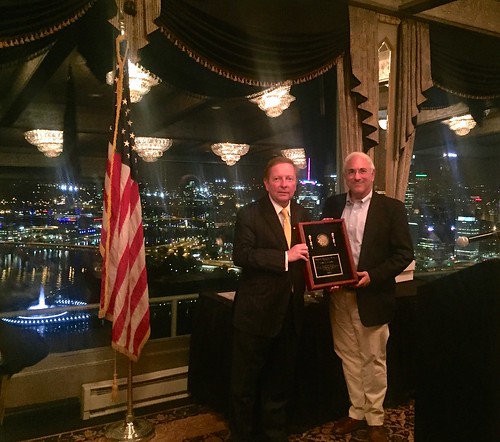
Tom Uram, Don Scarinci
BOTTOM LEFT: The Point Fountain at the confluence of Pittsburgh's three rivers
PAN was fortunate to have Don Scarinci come to our convention to open a window into the beauty and symbolism of medallic design. PAN President and fellow CCAC member Tom Uram presented Mr. Scarinci with a plaque of appreciation that included our PAN Logo medal dominated by the eagle design that was created by late Chief Engraver Frank Gasparro.
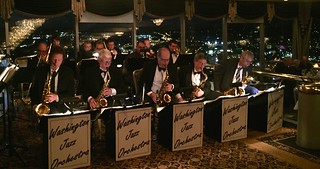 The PAN banquet continued as the band played on. The Washington Jazz Orchestra treated all of us to some great music throughout the evening. It was an over the top event!
The PAN banquet continued as the band played on. The Washington Jazz Orchestra treated all of us to some great music throughout the evening. It was an over the top event!
One of the banquet highlights is the presentation of the PAN Dealer of the Year Award. We have started this back up after a long absence. PAN has recognized that successful coin shows rely on the collectors, volunteers and the dealers that choose to participate in the organization’s success. We have begun to notice a resurgence in dealers that make the extra effort to promote PAN during their travels around the show circuit.
This year we were proud and delighted to present this recognition to Ed Hammond of Running Bear Coins from Kanona, NY. Since Ed started setting up at PAN shows he has typically made time to chat with us on ways that we can improve our show from the dealer’s perspective. We have implemented many of his suggestions that have proved to be successful. We often strive to make each coin show a little better for both our dealers and customers.
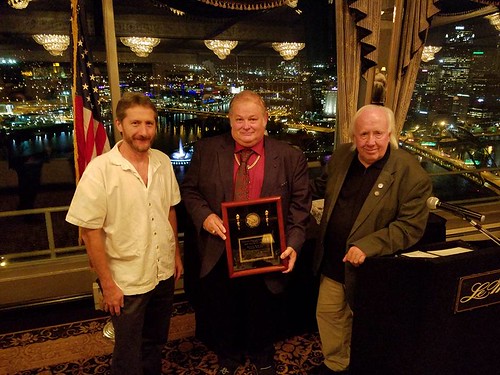
Allan Stullenbarger, Ed Hammond, Pat McBride
PAN is very fortunate to have a group of board members that are genuinely interested in what our dealers think and are receptive to their input. We view our organization, dealers and attending collectors as a partnership with the end goal of creating an enjoyable and prosperous environment for all. The photo shows 2016 Dealer of the year Alan Stullenbarger, founder of CoinZip.com, Ed holding his award and myself, Pat McBride.
Pat adds:
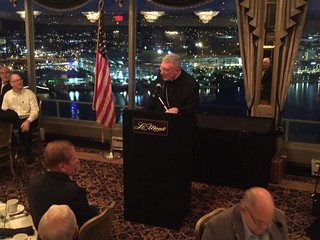 Bishop David Zubik gave the invocation. Tom called the Diocese because he found out that the Bishop was going to be in the restaurant for a Catholic Charities event in another room. The
Bishop agreed to stop in and regaled us with a story of how he learned a new word (numismatist) this evening. PAN has friends in high places!
Bishop David Zubik gave the invocation. Tom called the Diocese because he found out that the Bishop was going to be in the restaurant for a Catholic Charities event in another room. The
Bishop agreed to stop in and regaled us with a story of how he learned a new word (numismatist) this evening. PAN has friends in high places!
For more information about PAN, see:
https://pancoins.org/
2018 NEW YORK INTERNATIONAL EVENTS
 In addition to the Kolbe-Fanning book auction, there are quite a number of interesting events planned for this week's New York International Numismatic Convention. Here are some
announcements sent in by our readers. -Editor
In addition to the Kolbe-Fanning book auction, there are quite a number of interesting events planned for this week's New York International Numismatic Convention. Here are some
announcements sent in by our readers. -EditorMedal Collectors of America
Saturday, Noon
Our January club meeting in New York is shaping up to be another blockbuster. Dr. Lawrence Lee will be the keynote speaker. Dr. Lee’s presentation will focus on the Crane collection of Indian Peace Medals at the Denver Museum of Nature & Science. Everyone is invited and welcome. Our January meeting is held every year in conjunction with the New York International Numismatic Convention. It will take place at noon on Saturday January 13, 2018. The show is at the Grand Hyatt Hotel located at 109 East 42nd Street, New York, NY 10022, between Park and Lexington Avenues. Our meeting is in the Julliard room and anyone planning to attend should have no problem finding it once at the convention hotel. If you have any questions about the show, please visit their website at: http://www.nyinc.info/index.php; or email any one of the officers.
British Numismatic Society
Saturday 4pm
The meeting will take place on Saturday 13 January, at the Uris Room, Grand Hyatt Hotel, New York, at 4pm, in conjunction with the 46th New York International Numismatic Convention
Our speaker is David Vagi (Certified Collectibles Group, Sarasota, FL), and David’s presentation is entitled "Roman coins and the province of Britannia”.
When the Roman emperor Claudius invaded Britain in AD 43 he encountered a thriving Iron Age culture that often has been described as ‘Celtic’. Once a Roman presence was established, Rome’s coinage began to circulate on an increasingly large scale. Soon it displaced local currencies and came into common usage. Like any of Rome’s provinces, Britain was the site of periodic uprisings and a wide range of imperial concerns. On some occasions this led to special coin types referencing Britain, notably under Claudius, Hadrian, Antoninus Pius, Commodus and the Severans. In the later 3rd century AD a variety of new coinages began to circulate in Britain. They include imitative issues (often called ‘barbarous radiates’) and coins of the rebel-emperor Carausius, who established Roman-style mints in Britain. After his successor, Allectus, was defeated in 296/7, the Romans continued to strike coins in Britain well into the 4th century.
We would like to extend a warm welcome to all, whether a member of the Society or not.
The British Numismatic Society (founded 1903) exists to promote the study of coins, tokens, medals and paper money of the British Isles, the Commonwealth and other territories that have been subject to British rule. Details of membership may be had from the Secretary, Peter Preston-Morley, secretary@britnumsoc.org
For more information on the show, see:
http://www.nyinc.info/

2018 ONTARIO NUMISMATIC ASSOCIATION CONVENTION
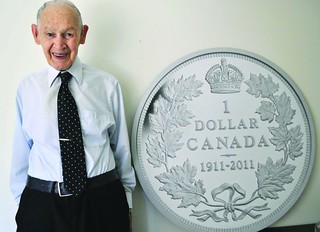 The keynote speaker for this year’s Ontario Numismatic Association (ONA) Convention banquet is James Charlton Jr., who will speak about his father and iconic Canadian numismatist James E.
Charlton.
The keynote speaker for this year’s Ontario Numismatic Association (ONA) Convention banquet is James Charlton Jr., who will speak about his father and iconic Canadian numismatist James E.
Charlton.
“Jim Charlton probably did more to popularize the coin hobby than any other individual in the last 50 years,” Geoffrey Bell, who was RCNA president from 1983-85 and again from 2001-03, told CCN in 2013. “He was a man of integrity, honesty and always asked fair prices when dealing. He encouraged new ventures that I personally experienced when we opened our auction house. He was generous to a fault that mirrored his Salvation Army faith.”
The elder Charlton began collecting coins at the age of 15, when his brother gave him an 1863 U.S. Indian Head cent. This numismatic interest stayed with him, and he eventually became a beloved dealer, auctioneer, author and publisher. A string of catalogues considered to be “the Bible” of Canadian numismatics continues to be published under his name; in fact, the 71st edition of the Charlton Standard Catalogue of Canadian Coins was released in July 2017.
Charlton died in September 2013 at the age of 103.
His son, James Jr., will be speaking about his father’s contributions to numismatics at the ONA’s banquet.
On April 20 from 1 p.m.-4 p.m., the ONA will host a three-part educational symposium featuring a trio of esteemed speakers.
“It is my hope that everyone will attend what is sure to be an informative look at our world of numismatics. From education we gain knowledge. With knowledge we gain wisdom,” said Douglas, who’s also the association’s educational chair as well as the Royal Canadian Numismatic Association (RCNA).
The first speaker will be France Waychison, who will lead a presentation about wooden money in Timmins at 1 p.m. A native of Coaticook, Qué., Waychison has been actively collecting wooden money for more than a decade and is currently president of the Canadian Association of Wooden Money Collectors.
At 2 p.m., Bill Waychison will lead a presentation entitled “The Story of Three War-Related Medals from France.” Currently residing in Timmins, Ont., Waychison is past president of both the Canadian Numismatic Research Society (CNRS) and RCNA and has served as the RCNA club services chair and ONA awards chair. He’s a Fellow of the ONA, RCNA, and CNRS and is recipient of the ONA Award of Merit, the Bruce H. Raszmann Award as well as the ONA, RCNA, and American Numismatic Association Presidential Awards.
Lastly, at 3 p.m., Douglas will lead a presentation entitled “W. R. McColl – Traces of A Numismatic Past.” In addition to serving as president of the ONA, Douglas is also the immediate past president of the CNRS. He is a Fellow of the ONA, CNRS and the RCNA and received the ONA Award of Merit in 2010.
To read the complete article, see:
Iconic Canadian numismatist focus of 2018 ONA Convention
(https://canadiancoinnews.com/iconic-canadian-numismatist-focus-2018-ona-convention/)
2018 BOSTON MCA CONFERENCE PLANNED

ART AND MEMORY: THE ROLE OF MEDALS
MCA CONFERENCE – BOSTON, OCTOBER 20, 2018
In anticipation of the Red Sox making it into the 2018 World Series, the MCA is planning a grand celebration, social event, and conference in Boston for Saturday, October 20. (The Series starts on the 23rd.) This conference – with the theme Art and Memory: The Role of Medals – will provide a venue for scholarly presentations and discussion around a range of topics related to collecting and enjoying medals, with plenty of time around the edges for social enjoyment.
The theme was chosen to have broad appeal, with social events added so that we have some fun, encourage discussion among medal collectors, and can engage with others who are not yet collecting. It will be held at the Massachusetts Historical Society, which is headquartered in a beautiful Beaux Arts building in Boston’s historic Back Bay. MHS members will be invited to attend as well, offering us an opportunity to broaden our network of friends with a passion for history and art. Anne Bentley, MHS Curator of Art & Artifacts, will arrange a special exhibit of medals from their fabulous collection.
Presenters are still being lined up, but will include:
Alan Stahl, Curator of Numismatics at Princeton and previously curator for many years at the ANS, will talk on the role of medals in American History
Henry Duffy, Curator at the St. Gaudens National Historic Site, will talk on the art of Augustus St. Gaudens, with an emphasis on his numismatic work
Len Augsburger, Coordinator of the Newman Numismatic Portal, will talk on the history of medal books …and a few other numismatic and art world luminaries still to be confirmed
Panel Discussions will include:
“The art of the medal – the past, present and future of traditional to contemporary art medals” – Ira Rezak, moderator
“What interests do medal collectors have in common?” – John Adams, moderator
Social Events will include: Friday evening – Casual welcome dinner (for early arrivals) at a Back Bay restaurant, or perhaps the hotel where we hope to arrange a group rate
Coffee on Saturday morning, with lunch and two breaks at the MHS
Saturday evening – Reception with drinks and hors d’oeuvres at a Back Bay restaurant within walking distance of the MHS and hotel
We are still in the planning stage, so please provide your input in New York at our January meeting, or email John Sallay (john@sallay.net) with ideas and suggestions.
Further details and registration information will be provided in the next few issues of The Advisory. In the meantime, mark your calendars for Saturday, October 20, 2018 in Boston!
For more information about MCA, see:
Medal Collectors of America (https://www.medalcollectors.org/)
PAPERS ACCEPTED FOR SUNDMAN LECTURE SERIES
Talks at the World’s Fair of Money Focus on Poor Richard
The American Numismatic Association (ANA) is currently accepting proposals for the 2018 Maynard Sundman Littleton Coin Company Lecture Series. Presentations will be given Aug. 15 during the symposium at the Philadelphia World’s Fair of Money®. Proposals must be received by Feb. 26.
Beloved historical figure, scientist, inventor and author Benjamin Franklin is revered for his contributions to American numismatics. To highlight the Founding Father’s role in shaping U.S. money, the 2018 theme for the Sundman Lecture Series will be “Fugio to Franklins: The Influence of Poor Richard.”
Those who wish to present at this year’s symposium must submit a lecture summary of 500 words or less. Each summary should contain an introduction, a brief discussion of the subject, sources and research method. Summaries will be reviewed and speakers evaluated and chosen based on originality, persuasiveness and relevance to the symposium topic. Selected presenters will receive a $250 honorarium.
Electronic submissions are preferred and can be emailed to seminars@money.org
COIN SHOW ATTENDANCE: THE PUBLIC/DEALER RATIO
The December 2017 PAN eNEWS had an interesting article which discussed attendence at the Pennsylvania Association of Numismatists coin shows in relation to other shows. -Editor
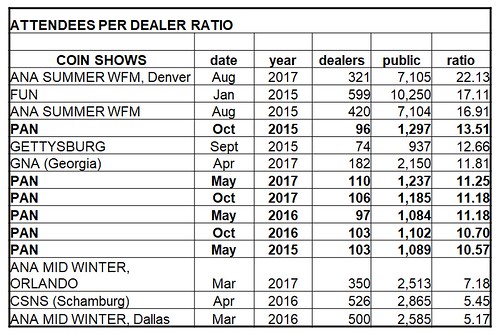
One of the statistics that we like to do is to attempt to track the number of dealers and attendees at coin shows and create a ratio. These are difficult numbers to acquire since not all shows publish both numbers. We have been able to assemble some comparisons for the last few years of a few coin shows. The attendance numbers presented do not include dealers and table help. Some shows combine both so we subtracted the number of dealers listed in their directories. Our goal was to see how the PAN shows stacked up as compared to others.
We have never published this list before and have stats going back to 2013. If you run a coin show then we would be grateful for your accurate numbers. We view this as a tool to determine the trends and health of the coin business. Major national shows tend to have attendees that are serious buyers. Smaller shows may have a mix of serious to curiosity seekers. There are many other factors that determine the success of a coin show. This is only presented as food for thought. Your thoughts? Email us mailto:pancoins@gmail.com
Pat adds:
I plucked these numbers from published news releases; you need both figures to make a ratio; there is a lot of guessing and hype out there, but we'll use whatever we can get. If anyone can provide numbers for other regional and national shows, I'd appreciate it.
One number not present here is the table fee, which is an important part of dealer calculus. How much does it cost me per attendee? Again, these measures only go so far; I don't think anyone has estimates of dealer revenue - as mentioned above, a single deal can make or break a show. -Editor
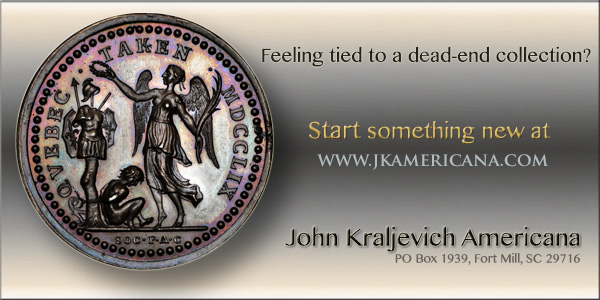
NUMISMATIC NUGGETS: JANUARY 7, 2018
Heslop's Middlesex Halfpenny Token
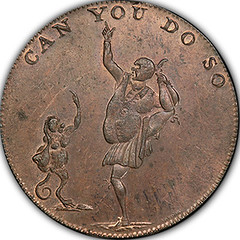
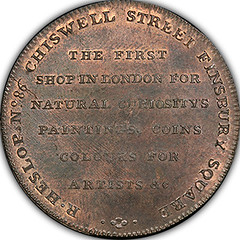
This choice Conder token features a creature who appears to be straight from a Dr. Seuss story and an impressively flexible person with a beer gut.
To read the complete lot description, see:
1790's (ND) Heslop's Middlesex Halfpenny Token DH-336b
(https://www.northeastcoin.com/popupcontainer.jsp?include=vi&itemKey=zi29_34021901)
1907 Argentina Santa Fe Province Medal


To read the complete lot description, see:
Lot 21: 1907 Argentina Santa Fe Province Silver 4 oz Medal (https://www.invaluable.com/auction-lot/-1-c-3F74198A27)
1871 Robert E. Lee Medal
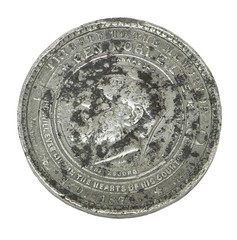
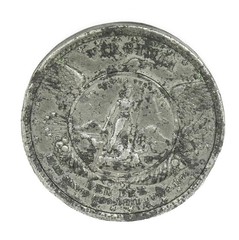
Description: Medal: "Tribute to the Memory of Gen. Robt E. Lee, at one side a bust in the likeness of Lee surrounded by the names of several Civil War battle names over "N.O. 1871" (New Orleans), the opposite side with the Virginia state seal above Lee's birth and death dates, GEN LEE BORN JAN. 19 1807 - DIED OCT. 12 1870, a medal used to raise money for the New Orleans statue of Lee finally completed in 1884 and dedicated on Washington's birthday in a "ceremony attended by former Confederate President Jefferson Davis, two daughters of General Lee, and Confederate General P. G. T. Beauregard", the Lee stature was removed to an unknown location on May 19, 2017, 1.7/8" diameter, dent at one edge
A Google search for better images of the medal took me to the Newman Numismatic Portal image collection, which in turn took me back to our own E-Sylum archive. Here's the image, which was provided by Confederate Numismatica author Peter Bertram just a couple months ago. -Editor
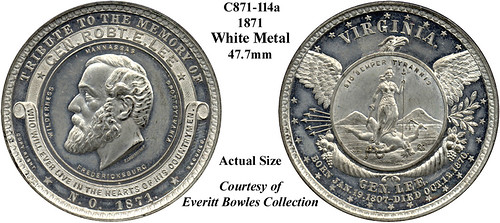
To read the complete lot description, see:
Lot 349: SCARCE 1871 ROBERT E. LEE NEW ORLEANS MEDAL (https://www.invaluable.com/auction-lot/-1-c-2FD49D2849)
To read the earlier E-Sylum article, see:
1871 ROBERT E. LEE MEDAL CORRECTION (http://www.coinbooks.org/v20/esylum_v20n45a07.html)
ULBRICH COLLECTION OF SILVER INDIAN PEACE MEDALS
In addition to being my best client for over three decades, Dick Ulbrich was also one of my best friends. We would sit in his den for hours on end discussing antiques, numismatics, politics, or the state of the nation. His death in 2008 left a permanent void in my life.
Though best known for his incomparable collection of early American arms and armaments, Dick had superb accumulations of political items, colonial numismatics, exonumia and numerous other types of American historical artifacts.
I am honored to present here his amazing collection of silver Indian peace medals, to be sold together as one group.
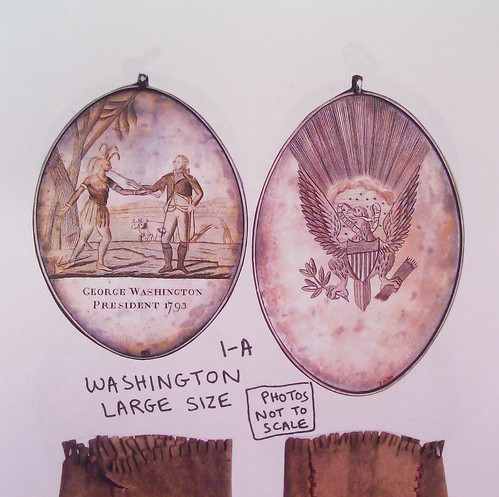
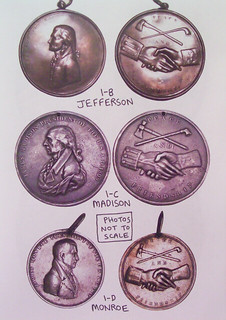

ARTICLE HIGHLIGHTS MANSFIELD, OHIO PAPER MONEY
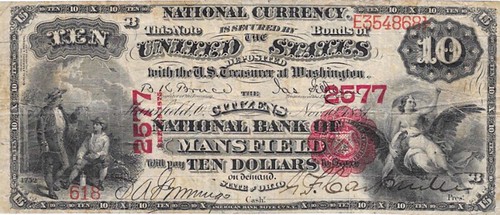
If there is anything that could confirm evidence of the stature of our town, with almost mythic American legitimacy, it would be seeing our name printed prominently on the face of Federal crisp green bills.
There it is, on one supremely sanctioned official unit of legal tender, like a sacred seal: Mansfield, Ohio next to an iconic President, with liberty and justice for all.
Nothing confers validity like money; our confirmation that the United States mint recognizes Mansfield, Ohio.
Here are some bills—a whole wallet full—that offer proof our hometown has achieved the gold standard of authenticity in American history.
Cash in the wilderness
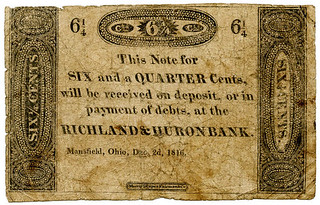 The story of Mansfield’s currency goes clear back to frontier days when the town numbered fewer than 500 people. In those early times, when the county was still mostly forest and gangs of
Wyandots still passed through the Square, commerce existed in a barter economy.
The story of Mansfield’s currency goes clear back to frontier days when the town numbered fewer than 500 people. In those early times, when the county was still mostly forest and gangs of
Wyandots still passed through the Square, commerce existed in a barter economy.
The US Government was not yet in the business of minting paper money, so everything Federally sanctioned was in the form of hard coin.
A local grocer in 1818 advertised that the store would sell their goods “for cash, or bear skins, deer skins, venison hams, and furs.”
But any town that wanted to show up on the map needed a bank, so in 1816 eager entrepreneurs cobbled together the Richland & Huron Bank of Mansfield. They printed lovely paper currency before the State Legislature even confirmed their charter; and when the State refused to recognize them they went ahead and opened for business anyway.
Mansfield’s first financial institution was a wildcat bank.
Only three months after their grand opening, their wagon had rolled into the deep mud with dozens of law suits; within a year it was completely swamped under hundreds of thorny litigations. Five years later, all of the bank officers had lost their shirts, their lands, their credibility.
These beautiful bills were not ‘worth the paper they were printed on’ for very long.
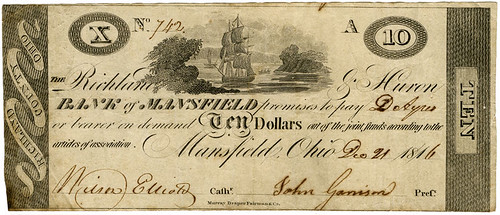
Below are some additional illustrations from the article. Be sure to read the complete piece online for more. -Editor
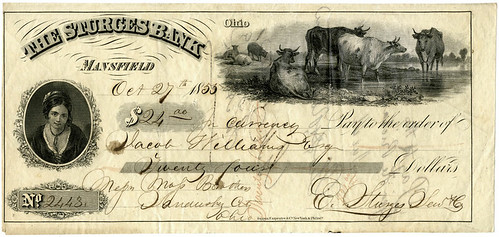
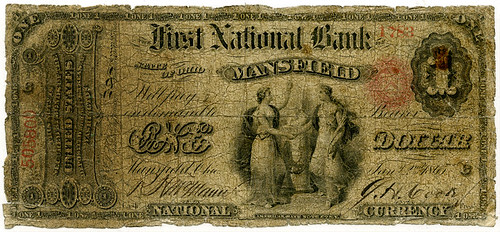
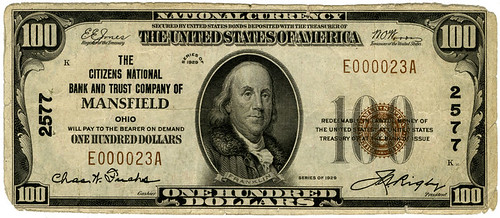
To read the complete article, see:
Mansfield & the fine art of Greenbacks
(http://www.richlandsource.com/area_history/mansfield-the-fine-art-of-greenbacks/article_3af807ba-efdc-11e7-a4be-4fa1f2fe2c25.html)
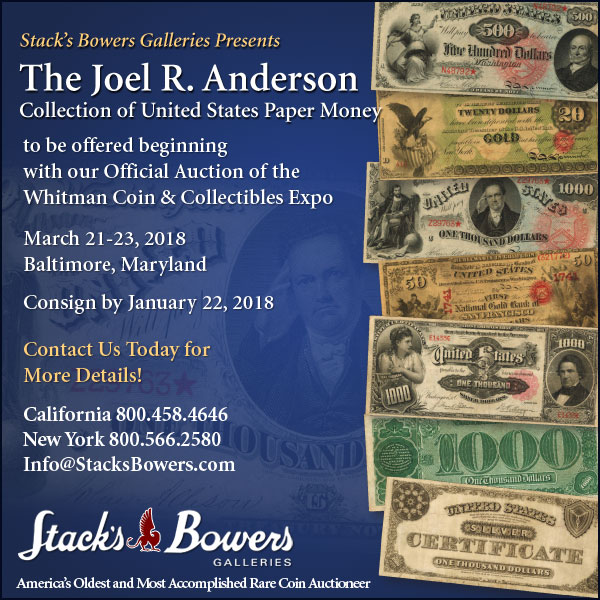
ROMAN SILVER COINS FOUND NEAR GLOUCESTER
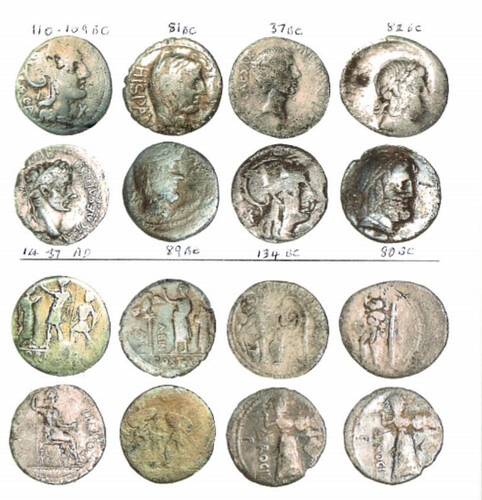
Metal detector enthusiast Susan Hurrell believes she has made the find of her life - a hoard of eight silver Roman coins dating back about 2,000 years.
The 66-year-old from Cinderford found them in a field off the A40 near Gloucester.
She said: “They date from 134BC to 37AD. Seven of the coins are over 2,000 years old.
“A hoard of this type is a first for Gloucestershire in that the coins are so ancient and are all of different emperors.”
Delighted to have found something of such historic importance, she admitted she would like to keep the coins - even if it meant she might have to pay money to the farmer whose land she found it on.
Stressing that she had the farmer’s permission to use her metal detector there before she made her find, she added that more ancient coins could be there.
To read the complete article, see:
Metal detector enthusiast makes find of her life when digging up 2,000-year-old
‘treasure’ (http://www.gloucestershirelive.co.uk/news/gloucester-news/metal-detector-enthusiast-makes-find-1006693)
MEXICAN 8 REALES BETWEEN AMERICA AND JAPAN
Kyle Ponterio writes:
I saw the article from Dan Owens about the 1859-S coinage and trade with China and Japan. I have heavily researched the time period he is talking about, but on the Japanese side from the American perspective. Please find attached an article that I wrote that was published in the US-Mexican Numismatic Association Journal in December 2015 along with a picture of an example of the subject matter.

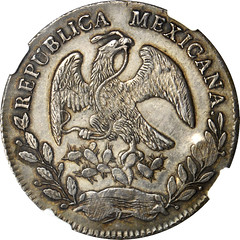
After nearly two years, on July 29, 1858, the treaty of Amity and Commerce was signed at Edo, but was not to come into full effect until July 4, 1859, in accordance with Article XIV. Lord Elgin, who was negotiating the British treaty, was not particularly happy with the date chosen for the American treaty to take full effect so he chose July 1 for the British treaty, causing it to take effect first. Harris’ hard work finally paid off when he was able to resolve several of the outstanding issues from Perry’s first treaty, such as the questions of currency and residency. Article III of the new treaty permitted the opening of additional ports allowing American citizens to permanently reside at such places as Kanagawa, opened July 4, 1859. On June 30, in anticipation of the opening of the new ports, the consulate was moved from Shimoda to Yokohama. On the July 7, accompanied by 23 fellow Americans, Harris established the American legation. The article also stated that six months after the opening of Yokohama, Shimoda was to be closed as it was not big enough to support trade and was surrounded by mountains, isolating it from the rest of the country.
The issue of currency was high on the priority list of all the foreign diplomats, and Harris was no exception. As early as September 1856 he had suggested that the exchange of coins should be based on weight. The Japanese argued that their coins contained more alloy than foreign coins and at first wanted a 25% discount to pay for the re-coining of foreign coins. Harris countered that 5% was sufficient and that the cost in Europe or America was less than 1%. He stated that he could employ a competent moneyer from the United States for 5% or less. He also informed them that he was aware of their long history of debasing currency. After this last point was brought to their attention, the Japanese relented and agreed that there should be a 6% discount to cover the cost of reminting foreign coins. Article V of the new Harris treaty states: “Americans and Japanese may freely use foreign coin in making payments to each other” and “All foreign coins shall be current in Japan, and pass for its corresponding weight of Japanese coin of the same description”. This article also states that for a period of one year after the opening of each harbor, Americans would be able to exchange coins, weight for weight, without penalty of discount. This was apparent in the port of Hakodate where foreign coins were countermarked with Japanese numerals specifying their weight accurate to less than 1% (however, the subject of Hakodate countermarks is for another time). It also stated that with the exception of Japanese copper coins, “coins of all descriptions may be exported from Japan, and foreign gold and silver un-coined”.
After the opening of Yokohama and the stipulations of exchange (as stated in Article V) denoting where coins were to circulate, weight for weight, the coins of the realm (“Mexican dollars”) were to be stamped at the customs house. The individual stamps Aratame, San, Bu and Sada were hand applied to the cap side of the “Mexican dollars”, meaning they have been determined to be worth three bu of silver. Merchants were now able to go to the customs house and obtain Japanese currency to conduct trade. They could exchange one “Mexican dollar” for three Ichibu, or on a larger more accurate scale 100 “Mexican dollars” to 311 Ichibu, minus the percentage stated in Article V. This provided an aggregate profit of about 70% on the exchange of four Ichibu for one gold Koban, which was worth about 12 “Mexican dollars” outside of Japan.
The exchange rate in Japan of gold to silver was approximately 1:5 and was disproportionate when compared to that of the rest of the world, which used a 1:15 ratio. This resulted in a mass exodus of gold. The increased exchange of Ichibu caused some alarm with officials who tried to limit how much one could receive per day and declared that only a small amount could be exchanged per individual. One documented account tells of Mr. Jack Ketch who applied for the astronomical amount of 1,200,666,777,888,999,222,321 Ichibu to be exchanged, knowing full well that he would only receive a small portion. Another failed attempt by the Japanese to stop the out flow of gold was their issuance of the debased Nishu, which was slightly bigger in size to the Ichibu, but with a purity of about 85% silver. These were not well received by the general populace.
It is theorized that the failed attempt to stop the out flow of gold by issuing debased currency led to “Mexican dollars” being re-coined, resulting in the relative scarcity of the Aratame San Bu Sada Gin. There does not seem to be a clear start date for when the “Mexican dollars” were countermarked, but it could not have been before the opening of Yokohama on July 4, 1859. However, there is a very clear end date of May 12, 1860 when production of these pieces ceased.
As stated above the countermarks were individually hand applied to the cap side of the “Mexican dollars”. In order by location (reading counterclockwise starting after the fineness) is Aratame (2 o’clock), San (1 o’clock), Bu (12 o’clock), Sada (11 o’clock). It does not appear that these were applied in any specific order, but each character was placed in a very specific location between the rays of the radiant Phrygian cap near the edge. Since these were applied by hand, the exact location in relation to the edge varies from piece to piece. The Howard Gibbs 1859-CCE piece is somewhat of a mint error having the first three countermarks in their usual locations, with sada located between the rays at 10 o’clock. The person applying these countermarks probably applied sada first then realized that it was in the wrong place and applied the other three in their respective locations. What can be ascertained from this is that the countermarks were in fact applied individually with very specific locations for each. As such this would also account for the uneven application of some of the punches.
To read the earlier E-Sylum article, see:
1859-S COINAGE AND TRADE WITH CHINA AND JAPAN (http://www.coinbooks.org/v20/esylum_v20n54a20.html)
HENRY MCARTHUR STRIKES FIRST COIN OF 2018
For many coin collectors down under, the Royal Australian Mint plays a very important part of their routine in terms of eventful New Year’s Eve celebrations. For almost two decades, eager collectors have stood out in line overnight — even spending more than one night in front of the mint complex — in order to be the first Australian to strike the first coin for the New Year. The lucky collector is given the chance to strike a coin and have the coin certified as the first coin — which becomes a very sought-after collector’s piece and worth a great sum of money.
This year, the Royal Australian Mint changed the method of who would be chosen to strike the first coin in 2018. The change included a lottery in which interested collectors were sold a ticket for $3 and a draw on the morning would determine the winner. Over 100 people took part in the draw where the Royal Australian Mint also took the opportunity to introduce the latest theme for commemorative coins. This year, the new coins pay homage to the contribution of convicts to Australia’s history, heritage, and folklore.
The Royal Australian Mint’s CEO Ross MacDairmid hosted the New Year’s event and invited one of the younger participants to “do the honours” and help with the draw. The task of choosing the winner was handed over to six-year-old Henry McArthur who lent a hand drawing the raffle for not only Australia’s first coin — but the world’s first coin of 2018. To everyone’s amazement, including a stunned Henry — he chose his own ticket.
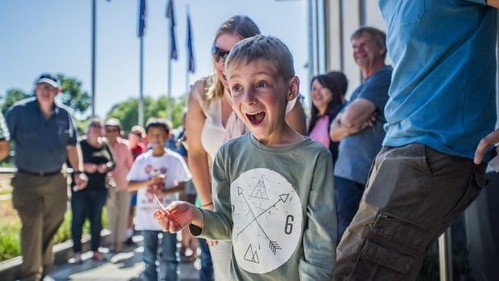
Henry, who along with his parents arrived at the Canberra Mint facility at 6:00 in the morning on New Year’s Day was heard to shout “I can’t believe it!” as he held up the ticket in delight.
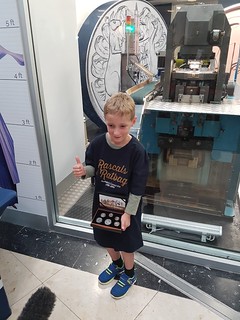 Henry went on to strike one of the new commemorative dollar coins which recognises Australia’s convict past, marking the 230th anniversary of the First Fleet’s arrival, as well as 150 years
since the last convicts transported to Australia set sail. Henry’s mother Judith also commented about her lucky son, “Look how excited he is, he’s shaking. I think we might go and buy a lotto ticket
now.”
Henry went on to strike one of the new commemorative dollar coins which recognises Australia’s convict past, marking the 230th anniversary of the First Fleet’s arrival, as well as 150 years
since the last convicts transported to Australia set sail. Henry’s mother Judith also commented about her lucky son, “Look how excited he is, he’s shaking. I think we might go and buy a lotto ticket
now.”
A spokesman for the Royal Australian Mint confirmed that about 250 people turned out for the event on Monday and that the change to a lottery draw was put in place for 2018 after a teenager was struck down with food poisoning, dehydration, and sunburn during his week-long wait outside the mint last year. The mint was concerned about the health of people who were lining up for long periods of time and the change seemed necessary — which has worked well in this instance.
The new series of “Rascals and Ratbags” base metal, silver, and gold commemorative coins are available from the Royal Australian Mint’s website.

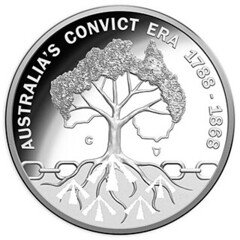
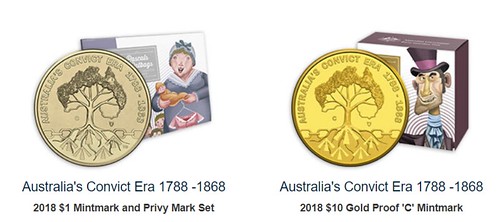
For more information, or to order, see:
Australia's Convict Era 1788 -1868 (eshop.ramint.gov.au/product-category.aspx?KWD=convict)
To read the complete article, see:
Australia: Young collector picks his own lottery number to strike first coin
for 2018 (http://news.coinupdate.com/australia-young-collector-picks-his-own-lottery-number-to-strike-first-coin-for-2018/)
THE 2018 ROYAL MINT FRANKENSTEIN COMMEMORATIVE
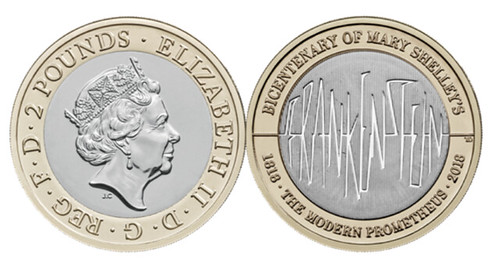
As a bibliophile, I went looking for an original edition of the book, which I've never actually read. The early printings had no illustrations. An 1831 edition on Internet Archive does have a depiction of Frankenstein's creature, much different from the film versions. -Editor
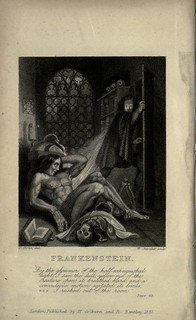
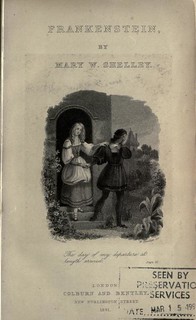
This is the influential 1831 edition which most people know the story by (there were two previous versions, substantially shorter). It is notable that an actual picture of "the creature" is depicted on the inside cover because the description in the text is vague. Shelly of course was alive when this edition was published although it is unclear if she had any influence on the creatures portrait for this edition. It is certainly much different, more human, than the 20th C Boris Karloff creature.
To read the book on Internet Archive, see:
Frankenstein, or, The modern Prometheus (https://archive.org/details/ghostseer01schiuoft)
For more information on the coin, or to order, see:
The 2018 United Kingdom Annual Coin Set
(https://www.royalmint.com/our-coins/ranges/annual-sets/The-2018-United-Kingdom-Brilliant-Uncirculated-Annual-Coin-Set/)
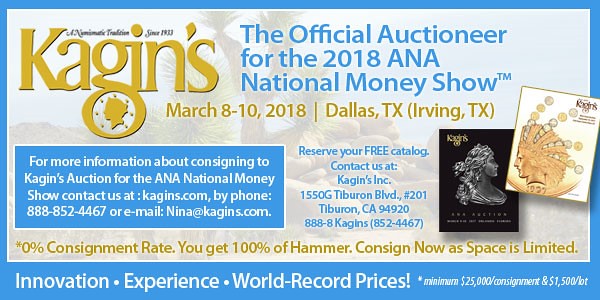
TOKENS OF THE CHISANA GOLD RUSH
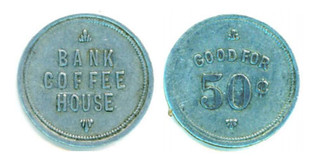 Having never been one to collect anything (other than wild game for the freezer), the purchase of a token off eBay was in fact a shock to myself and began my token collection. That first
token was a Bank Coffee House aluminum 50 cent piece and over the past few years I’ve been constantly searching to acquire a full set of tokens from the Chisana area.
Having never been one to collect anything (other than wild game for the freezer), the purchase of a token off eBay was in fact a shock to myself and began my token collection. That first
token was a Bank Coffee House aluminum 50 cent piece and over the past few years I’ve been constantly searching to acquire a full set of tokens from the Chisana area.
I have been visiting Chisana (pronounced Shoo-shaan-ah) since I was a child. Luckily for me my uncle, who has been exploring, prospecting and hunting in Chisana since the late 1960s, loves to share this place with family and friends. My grandparents bought property in Chisana after their first visit; built a home and lived there full time for over 30 years. I also own property and am currently building a cabin of my own.
Over the years I’ve heard many great stories about the “old days” in the Chisana area. They always involved tough, adventurous people braving the elements to chase their dreams, be it dreams of gold, fur, or in the case of my grandparents, retirement.
The mystery behind the tokens sparked my interest and had me digging deeper into the history of the area. Chisana was the center of the last great gold rush in Alaska. Not long after gold was discovered in the hills east of town in 1913, Chisana was known as the largest log cabin town in the world.
Thousands of miners flocked to the area hoping to strike it rich. General stores were quickly built along with saloons, diners and brothels to support the prospectors. The first store was built by Sam Shucklin. The rush was short lived, only lasting a couple years, but evidence of the bustling past of Chisana can still be seen if you look close enough.
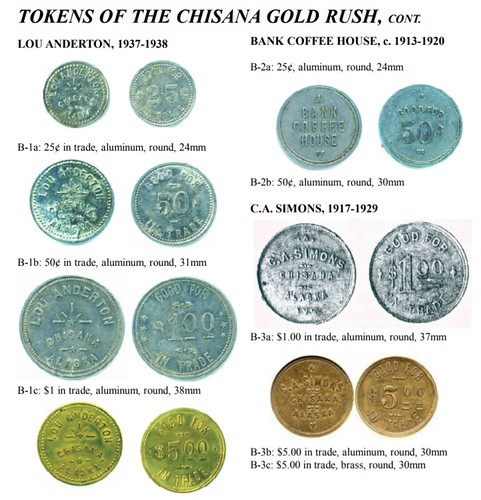
As for my collection, it’s still not complete. I’m on the hunt for a Bank Coffee House 25 Cents and a Simons $5 brass if anyone has one for sale. I never thought I’d be a token collector but now I can’t deny that I enjoy the hobby and the way it has inspired me to learn more about a place that is dear to my heart.
HOW TO HANDLE SELLING TOKEN AND MEDAL DIES
Tom Casper writes:
I read with interest the article in the last issue of The E-Sylum on the Anillo restrikes. I am aware of the problems they can cause for collectors, dealers and auction companies. Down the line these pieces are ultimately offered for sale as original strikes rather than restrikes or die-trial tokens, which is deceiving to the buyer.
I have a large collection of old token and medal dies. To prevent a repeat of Anillo problem, I was wondering if your readers have any suggestions for me before I dispose of this collection.
By coincidence, in a companion article to the one on the tokens of the Chisana gold rush in the January 2018 issue of Alaskan Token Collector & Polar Numismatist (see the article preceeding this one), editor Dick Hanscom discusses fantasies of the Chisana tokens struck from the original dies. With permission, here's an excerpt. -Editor
Editor’s Note: We acquired these dies, along with others from Dale Noll, a California collector about 1984/1985. We sold them to a local collector, and reacquired them in the last few years. At least the 25¢ obverse die was use to make fantasy restrikes before we acquired them the first time.
MORE ON THE CHISANA RESTRIKES
In the June, 1991 issue of Alaskan Token Collector & Polar Numismatist, I did an article on “Mint Sports.” These are “tokens” that were struck using the wrong die pairings, made to deceive. However, in this case, either that was not the purpose, or they were so badly done that anyone knowledgeable about Alaska tokens would not be deceived. I purchased several dies in 1984/1985. From the article, it appears that I still possessed the Chisana 25¢ obverse die in 1991.
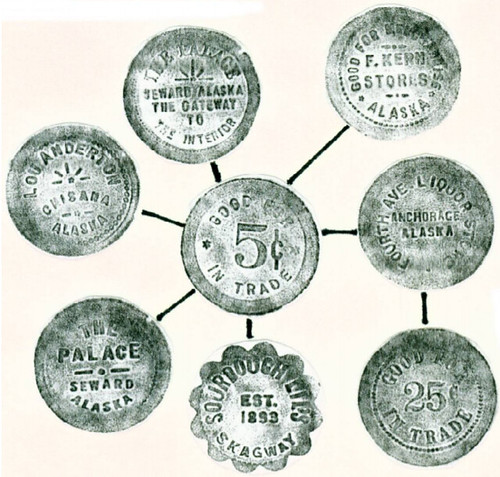
There are several token dies paired with a 5¢ reverse. These rubbings show something interesting. In this grouping, all of the planchets appear to be oversized, the tokens showing a very broad rim.
Jump ahead to 2017. I have re-acquired the Chisana dies, and decided to “play” with them. When I tried to make a blank for the Chisana 25¢ and 50¢ dies, I did not have a disc cutter the correct size. And I have 3 sets of disc cutters, all with cutters larger and smaller than the required size.
What does this tell me? It tells me that the last person to use these dies, and make the “mint sports” also did not have a disc cutter the correct size. As a matter of fact, it was the same size that I used to make the blanks for the 25¢ die!
It is interesting to note that the maker of these “mint sports” did not have the right size disc cutter, but did have access to octagonal and scalloped planchets.
I also reached out to Token and Medal Society officers Eric Schena and Dave Schenkman for their thoughts on the topic. -Editor
Dick adds:
Ron Benice in his book Alaska and Yukon Tokens makes a note of dies still known to be in existence with a little [D] in the listing with the tokens. There are a lot of them.
Eric Schena writes:
I have to say that the idea of defacing a die is anathema to me too, though I completely understand the rationale for doing so.
I collect token dies mostly from the Mid-Atlantic states, partially with the intent to keep them from being used to make restrikes or fantasies. I have made a point of doing exactly what Wayne suggests: maintaining a catalog of dies so that records of what dies are out in the wild are known. I feel that the dies themselves are valuable artifacts in their own right, so I am averse to defacing them.
The S. H. Quint's Sons Company of Philadelphia was a major producer of trade tokens and badges for many years. In the 1960s, Quint sold off their stock of trade token dies since they were moving away from that business - some 10,000 or 20,000 dies all told. They were sold in groups and there are even some ads in the TAMS Journal for them.
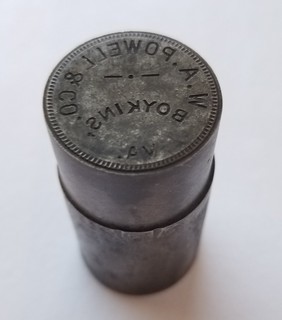 When the Quint dies were sold, they were not sold with their mated reverses to prevent accurate restrikes. That still has not stopped a few enterprising individuals from making fantasies
anyway. If I recall correctly, back in the 1970s, the obverse dies for tokens from Boykins and Limeton, Virginia were mated with unrelated reverse dies and used to produce fantasy pieces struck on
older US coins (mostly V nickels and Indian head cents).
When the Quint dies were sold, they were not sold with their mated reverses to prevent accurate restrikes. That still has not stopped a few enterprising individuals from making fantasies
anyway. If I recall correctly, back in the 1970s, the obverse dies for tokens from Boykins and Limeton, Virginia were mated with unrelated reverse dies and used to produce fantasy pieces struck on
older US coins (mostly V nickels and Indian head cents).
I have a couple of these fantasies (though I paid nothing for mine - I have seen these sell for crazy amounts, though) and will use them as educational tools. Fortunately, I managed to get those very dies recently and they will not be used for that purpose, at least not under my custodianship. I have about 60 such dies in my collection and hope to publish them at some point.
I believe that publishing this information helps at least raise awareness enough so that as few people as possible are taken in by these things without having to resort to destroying the dies. So, my advice would be to preserve them, but publish them. Spread the word and that will go a long way. Maybe write a catalog and perhaps contact TAMS for publishing in the TAMS Journal (Tom can contact me if he so wishes). At a bare minimum, find someone you can trust won't use them to make restrikes or fantasies.
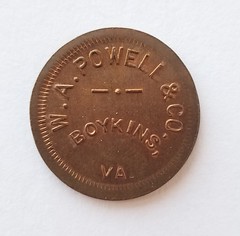

W. A. Powell Fantasy Token (die shown above)
Images courtesy Eric Schena
Dave Schenkman writes:
Eric summed it up well. Another suggestion would be to donate them to the American Numismatic Association.
I became acquainted with Carmen Valentino in 1968, around the time he joined the Token and Medal Society. Carmen had made an arrangement with S. H. Quint’s Sons Co. of Philadelphia to sell their old token dies; thousands of them. I purchased most of the Virginia token dies, and as I recall he charged me $7.50 each. These were just obverse dies, not matched pairs, although I did get ten dies from Planters Nut and Chocolate Company of Suffolk, VA; he sold me the matched obverse/reverse pairs because on these dies the company name appeared on each side.
To read the earlier E-Sylum article, see:
THE ANILLO TOKEN RESTRIKES (http://www.coinbooks.org/v20/esylum_v20n54a24.html)
THE WWI DISTINGUISHED CONDUCT MEDAL
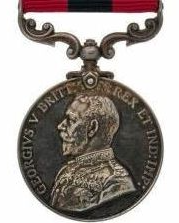 During this week a century ago, there is also the story of Sapper James O'Connell of Bangalow in The Northern Star who was awarded a distinguished conduct medal.
During this week a century ago, there is also the story of Sapper James O'Connell of Bangalow in The Northern Star who was awarded a distinguished conduct medal.
The story goes he was in the company cookhouse near the front line when the enemy attacked.
O'Connell realised there were many of them and he was isolated so he started to retreat in the direction of the nearby canal.
Knowing where there was a dump of bombs, he managed to get his hands on some and started throwing them at the enemy.
When he got to the canal, he was shot in the head, although not seriously and fell into the water.
Not only did he manage to get himself out of the canal, but he obtained more bombs and made another stand against the enemy who continued to attack.
They bombarded him with 'flammenwerfer' or flamethrowers which severely burned him, causing him to fall back into the canal, where this time he remained for half an hour, the enemy believing he had died.
He again managed to struggle out of the canal where he found a fellow officer who dressed his wounds.
By this stage the situation was if O'Connell remained where he was he would be taken a prisoner of war or he could escape by swimming the canal.
So for a third time he found himself in the water, swimming easily across the canal as he was a strong swimmer.
However, he heard cries for help from the middle of the canal from a fellow soldier who couldn't swim and was trying to escape the enemy on a piece of wood.
Despite his wounds and enemy gunfire overhead he dived a fourth time into the canal and managed to rescue his comrade.
He was recommended for a Victoria Cross but received the DCM instead.
To read the complete article, see:
Bangalow boy earns his medal 100 years ago
(https://www.northernstar.com.au/news/bangalow-boy-earns-his-medal-100-years-ago/3290499/)
QUERY: WERE THESE COINS MADE BY ISIS?
A web site visitor writes:
I was given some ISIS coins. The ones on your website do not correlate with ones I have. I am currently embedded with the YPG forces in Dier ez-Zor in Syria. I was given these coins by a Haval (comrade) that he found on the front line. But there seem to be a lot of different ones.
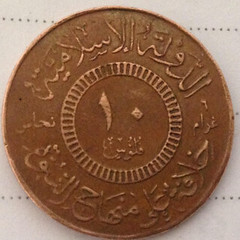
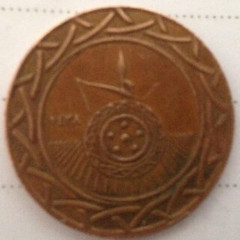
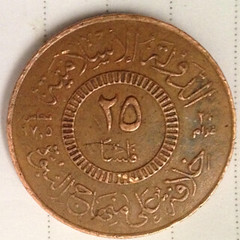

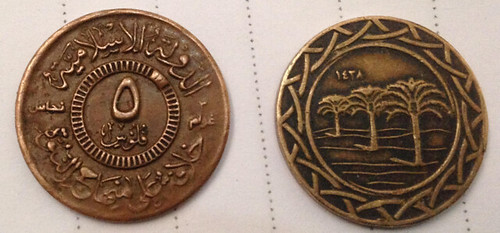
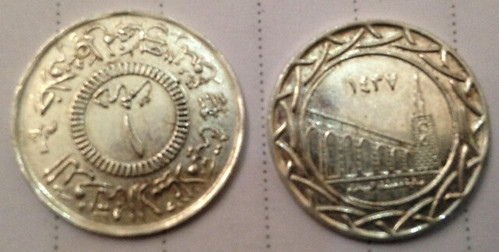
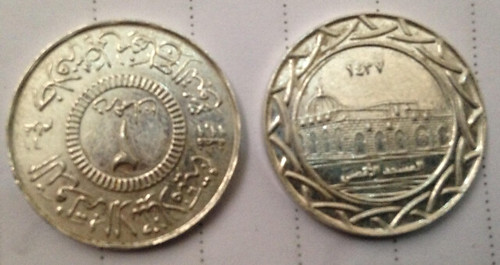
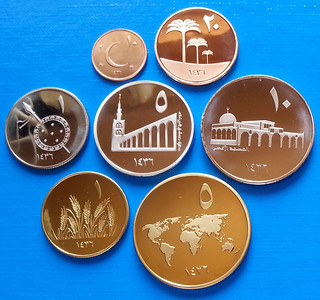
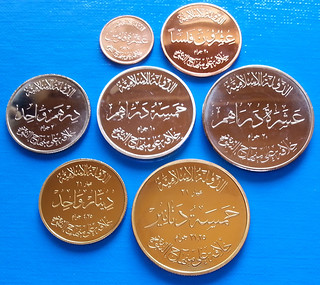
To read the earlier E-Sylum articles, see:
ISIS TO ISSUE ITS OWN COINAGE? (http://www.coinbooks.org/esylum_v17n47a25.html)
ARE ISIS COINS BEING MINTED IN CHINA? (http://www.coinbooks.org/esylum_v18n01a26.html)
ISIS VIDEO SHOWS GOLD DINARS BEING MINTED (http://www.coinbooks.org/esylum_v18n35a25.html)
ISIS DINARS: THE GOLD OF DAESH (http://www.coinbooks.org/esylum_v18n37a20.html)
ISIS MINT FOUND IN TURKEY (http://www.coinbooks.org/esylum_v18n41a21.html)
ISLAMIC STATE COINS ON EBAY (http://www.coinbooks.org/esylum_v19n34a40.html)
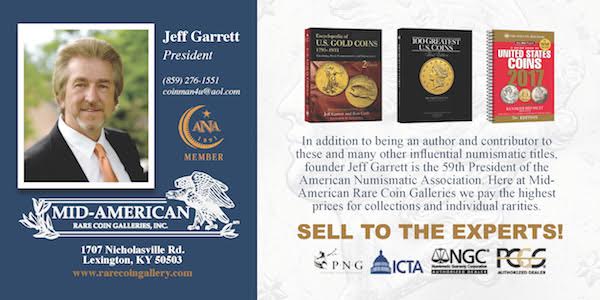
BEP ISSUE 2018 HAPPY BIRTHDAY NOTE
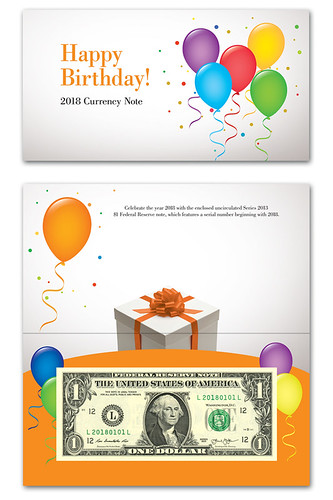 First Day of Sale: January 16, 2018 (8:00 a.m. ET) – The Bureau of Engraving and Printing (BEP) is pleased to introduce the 2018 Happy Birthday Currency Note, featuring a $1 note with a
serial number beginning with “2018.” The note is protected by a clear, acid-free polymer sleeve in an attractive folder. The 2018 Happy Birthday Currency Note is $5.95.
First Day of Sale: January 16, 2018 (8:00 a.m. ET) – The Bureau of Engraving and Printing (BEP) is pleased to introduce the 2018 Happy Birthday Currency Note, featuring a $1 note with a
serial number beginning with “2018.” The note is protected by a clear, acid-free polymer sleeve in an attractive folder. The 2018 Happy Birthday Currency Note is $5.95.
For more information, or to order, see:
2018 Happy Birthday Currency Note (http://www.moneyfactorystore.gov/
2018happybirthdaycurrencynote.aspx)
KENYAN ARTIST DESIGNS HIS OWN NEW BANKNOTES
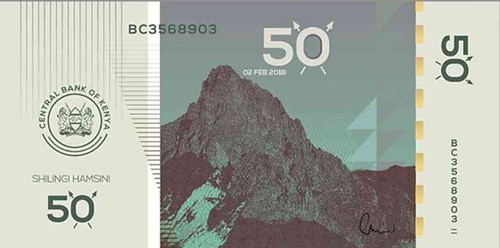
Radio Africa's Dicky Hockie did not expect as much attention as he has received when he attempted designing new notes for Kenya.
It was "trial and error", the digital department employee says, but there has been excitement on social media.
"I got the idea after seeing leaked notes designed a few weeks ago. I thought they could be better so I noted down the idea and worked on them during the Christmas break," he says.
In an interview on Thursday, Dicky says he did it for fun and that he did not have sketches of bank notes.
"It was completely trial and error. I had never done this before so it was a combination of thorough research and guess-work."
But the 30-year-old said his designs were a major improvement from what the country currently uses.
"I liked them. I am an artist ... a graphic designer ... I wasn't joking. I really tried to make the best-looking notes I could ... I did the designs in my free time just for fun."

The designs have pictures of wildlife and athletes, tourism and athletics being two of Kenya's top sectors.
Of these choices, the designer says: "Putting a fisi (hyena) on the notes is funny but I really don't think we should do it just for laughs."
Dicky, who shared the designs on social media on Wednesday, notes: "This is not legal tender and it is not sanctioned by CBK or the government."
His designs bear close resemblance to international currencies such as the Euro and may have piled pressure for CBK to do a good job.
Dicky thanked the public for their comments on what he terms a "truly Kenyan" project.
"I am not famous. I am however glad that Kenyans appreciated the project and began to reflect on what they consider truly Kenyan," he says.
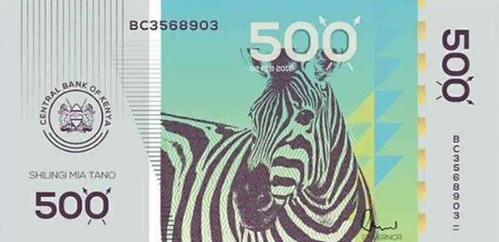
He says he would be astonished if Central Bank adopted the designs but adds he would take the opportunity to contribute.
"That would be an incredible surprise and I would be honoured to contribute."
CBK governor Patrick Njoroge said the new generation currency will be issued before the end of May 2018.
To read the complete article, see:
Kenyan designer dares CBK to unveil 'real notes' as sketches
go viral (https://www.the-star.co.ke/news/2018/01/04/kenyan-designer-dares-cbk-to-unveil-real-notes-as-sketches-go-viral_c1693345)
AUSSIE STEALS A HUNDRED TRILLION DOLLARS
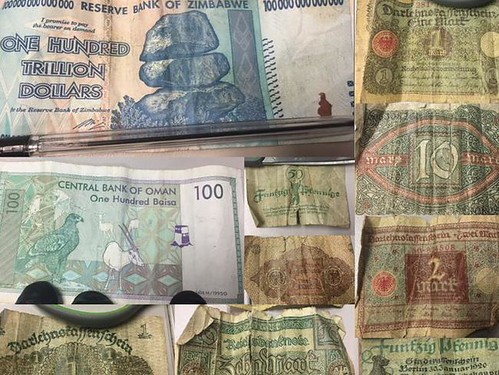
AN Australian man has been arrested for stealing trillions in overseas currency — not that he would have been able to buy much with it in this country.
The 32-year-old from Adelaide allegedly stole banknotes including German Deutschmarks printed in 1920, a thousand Korean Wons, 100 Baisa Oman notes and a hundred trillion dollar note of the defunct Zimbabwean dollar.
To read the complete article, see:
Aussie arrested for stealing a hundred
trillion dollars (https://www.dailytelegraph.com.au/business/aussie-arrested-for-stealing-a-hundred-trillion-dollars/news-story/1a5186bec54525165187488e8c9647ad)
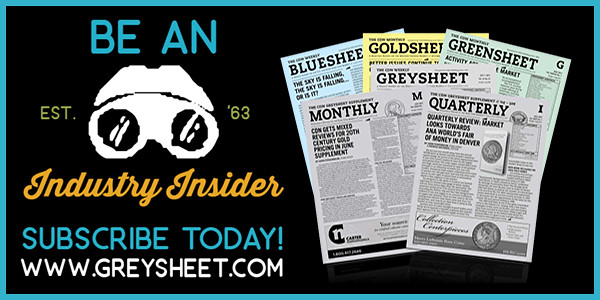
CHINA IS ALREADY LARGELY CASHLESS
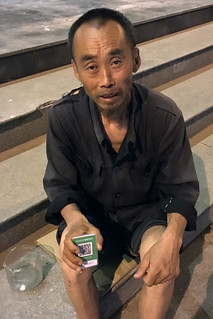 Soliciting handouts near a grocery store, Zhao Shenji, a slender man with shorn hair, made giving easy for Beijing residents accustomed to relying on their smartphones.
Soliciting handouts near a grocery store, Zhao Shenji, a slender man with shorn hair, made giving easy for Beijing residents accustomed to relying on their smartphones.
“Recommend using WeChat Pay,” said a placard the beggar displayed.
It was a literal sign of the times. Payment via mobile-phone services such as WeChat is sweeping the country. After gaining a beachhead as a means to buy things online, mobile payments moved on to store purchases and are fast becoming the way many people in China pay for just about everything.
That includes small personal debts. Richard Lau, a young management consultant waiting to get into the historic St. Michael’s Cathedral in Qingdao one recent day, found he had no cash for the 20-yuan admission, so he borrowed it from another man in line and immediately zapped him the amount by phone.
Behind the trend are internet titans Alibaba Group Holding Ltd. and Tencent Holdings Ltd., which are elbowing aside banks to take a growing role in daily commerce. Their success offers a glimpse of a future where technology firms drive innovations in finance just as they have in retailing, autos and the media.
Though the U.S. saw $112 billion of mobile payments in 2016, by a Forrester Research estimate, such payments in China totaled $9 trillion, according to iResearch Consulting Group, a Chinese firm.
For Alibaba and Tencent, the payoff isn’t just the transaction fees they make from merchants, typically 0.6%. It’s also the consumer data collected, which can transform their apps into marketing platforms for an expanding array of services, from bike sharing to travel.
WeChat Pay and Alipay are gaining attention in U.S. tourist centers after striking deals with hotels and resorts. A group of Chinese tourists recently dined at the Bacchanal Buffet at Caesars Palace in Las Vegas, where the menu includes T-bone Australian lamb, chilled crab legs and handmade dim sum. They settled their bill with a smartphone.

Paying toll with a SmartPhone
To read the complete article (subscription required), see:
The Cashless Society Has Arrived— Only It’s in China
(https://www.wsj.com/articles/chinas-mobile-payment-boom-changes-how-people-shop-borrow-even-panhandle-1515000570)
To read the earlier E-Sylum article, see:
NEW YORK CITY CREEPING TOWARD CASHLESSNESS (http://www.coinbooks.org/v20/esylum_v20n54a30.html)
FEATURED WEB SITE: HISTORY OF PHILIPPINE COINS
This week's Featured Web Site is a slideshow on the history of Philippine coinage.History of Philippine coin
Prepared By: Ella B. Dimaiwat BSAETM (Bachelor of Science in AgriEcotourism Management)
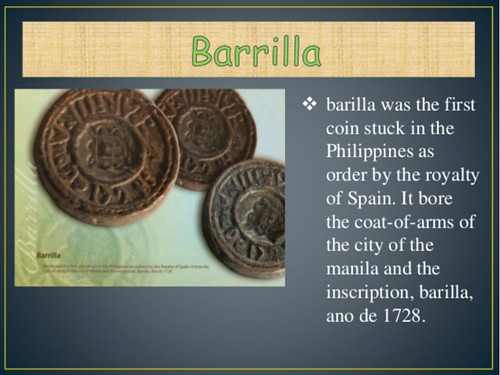
https://www.slideshare.net/elladimaiwat/
history-of-philippine-coin

